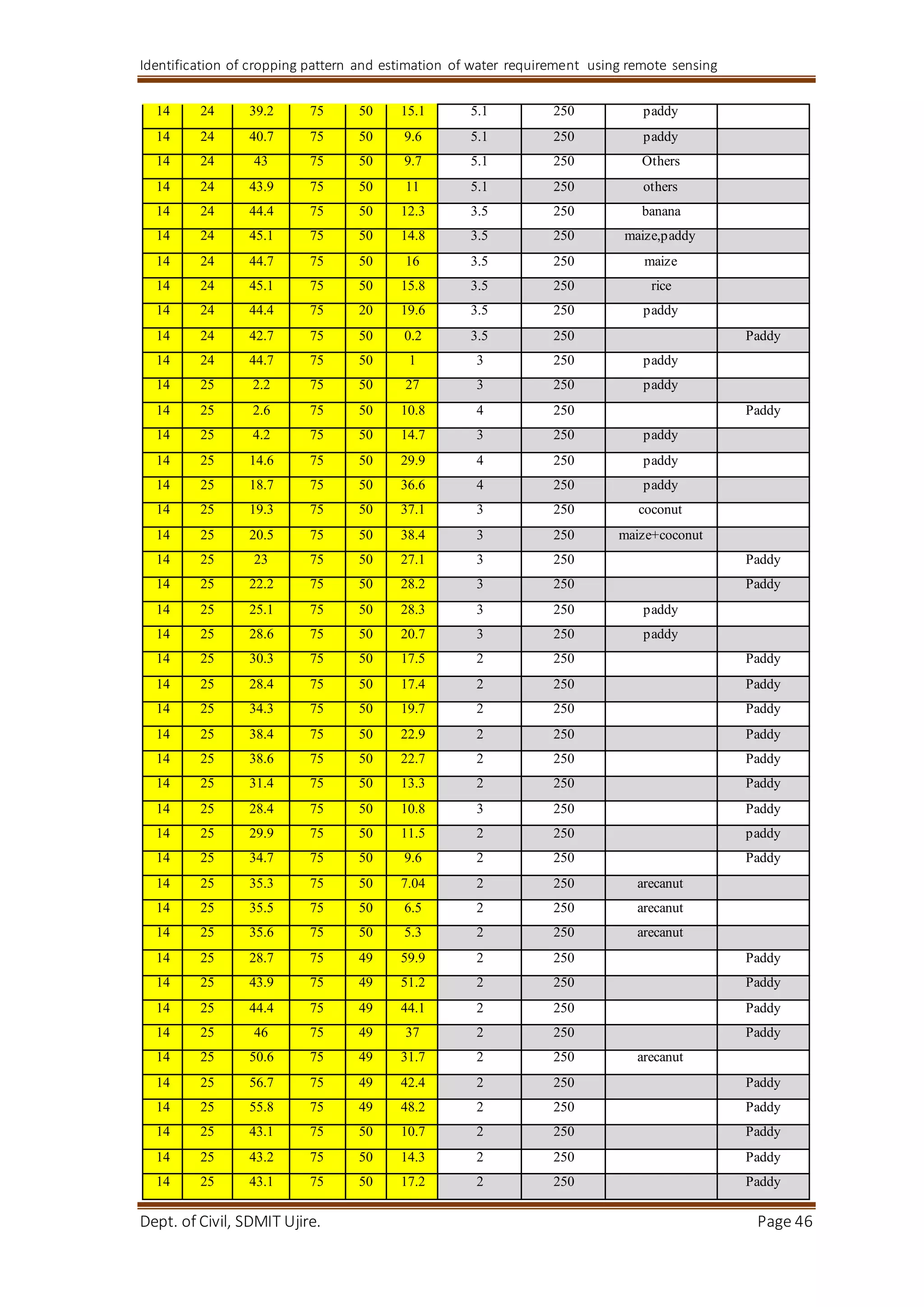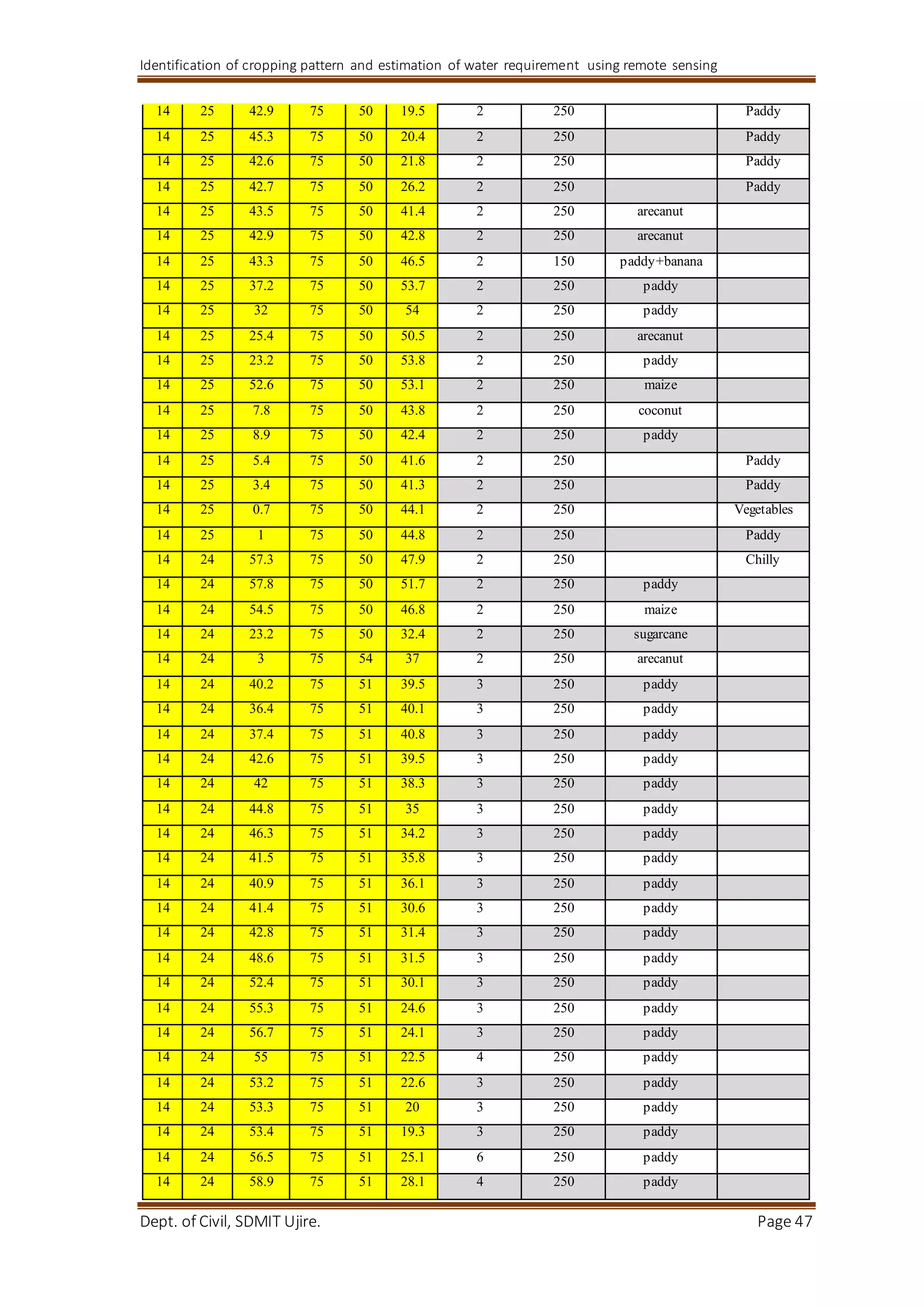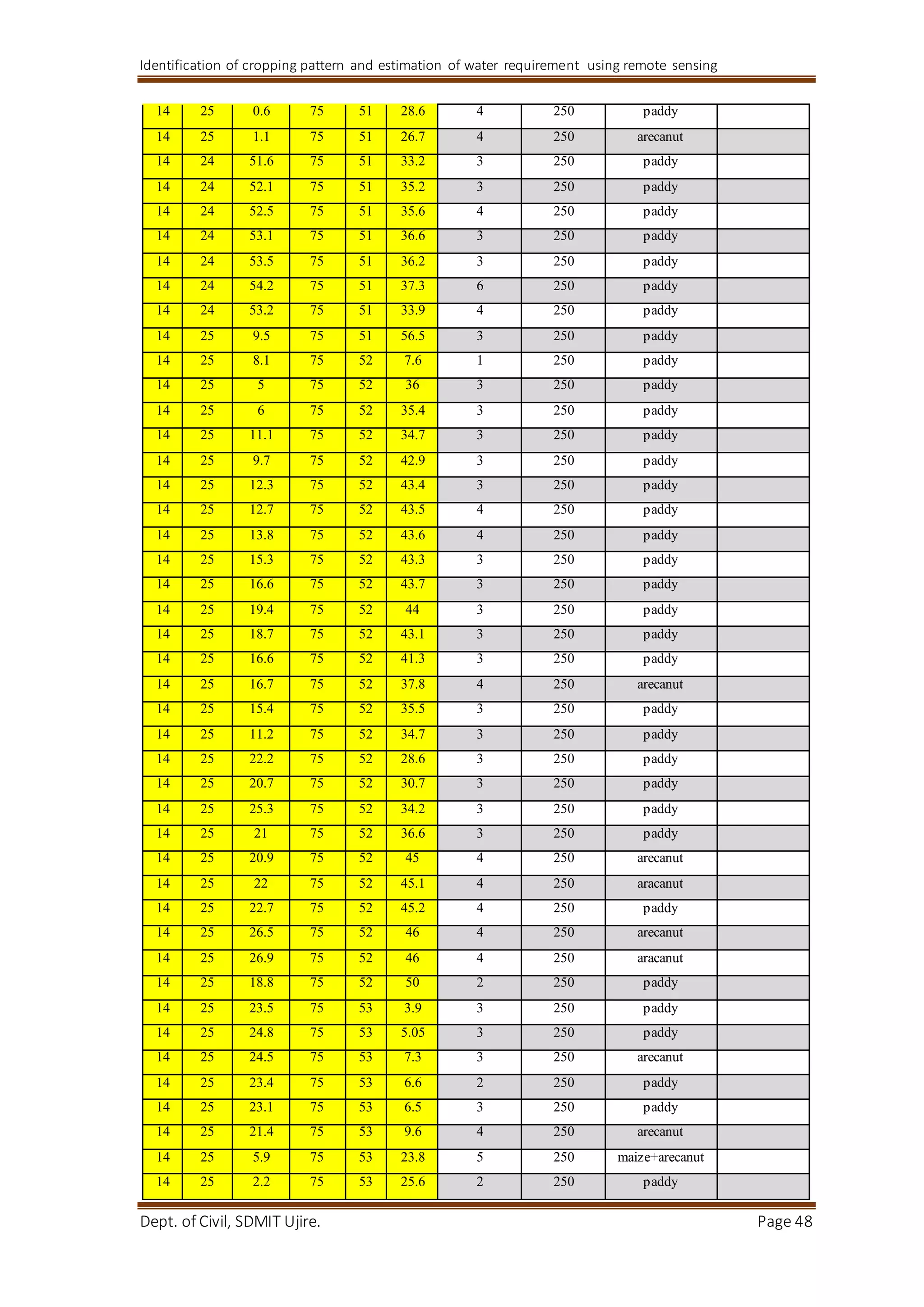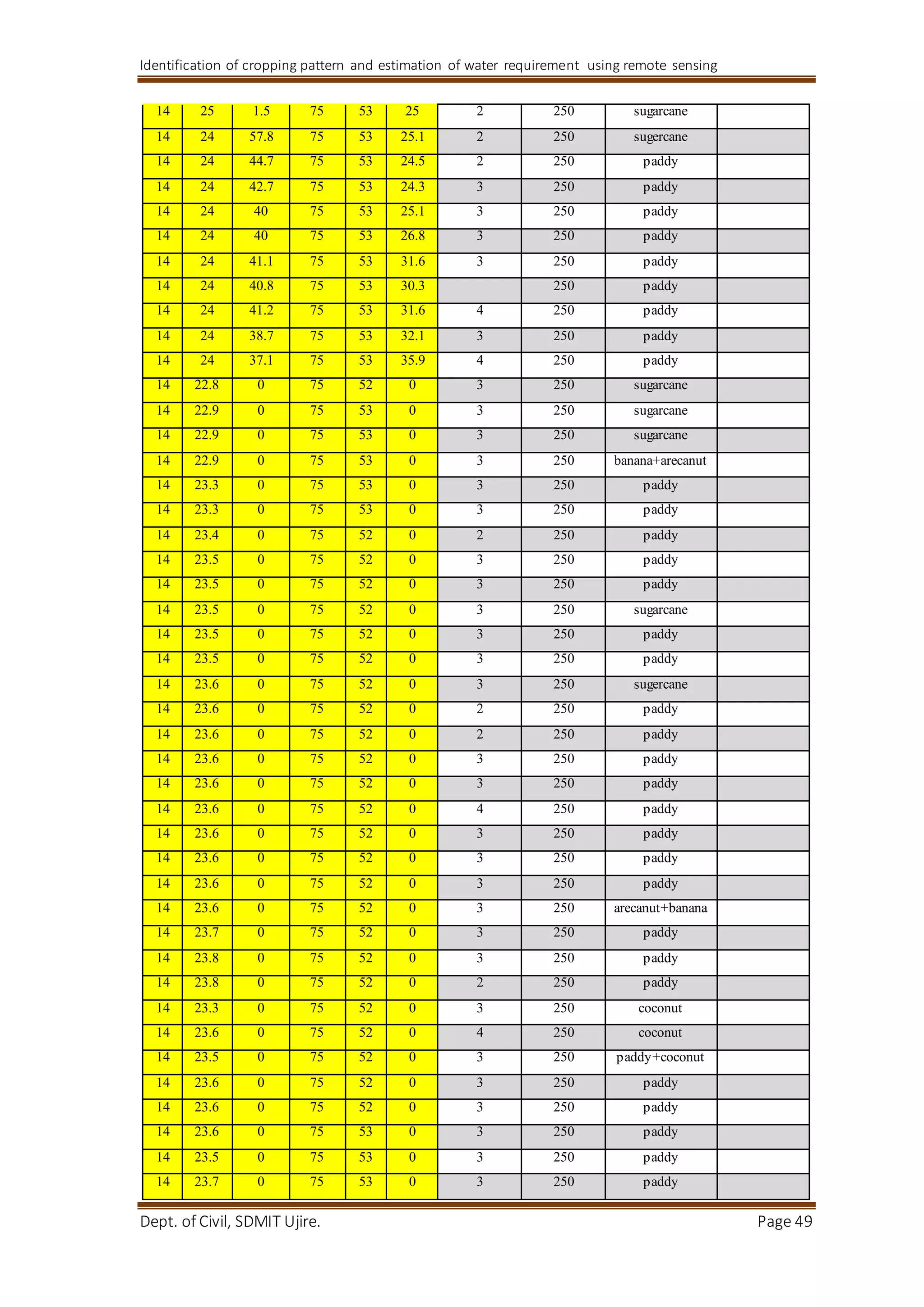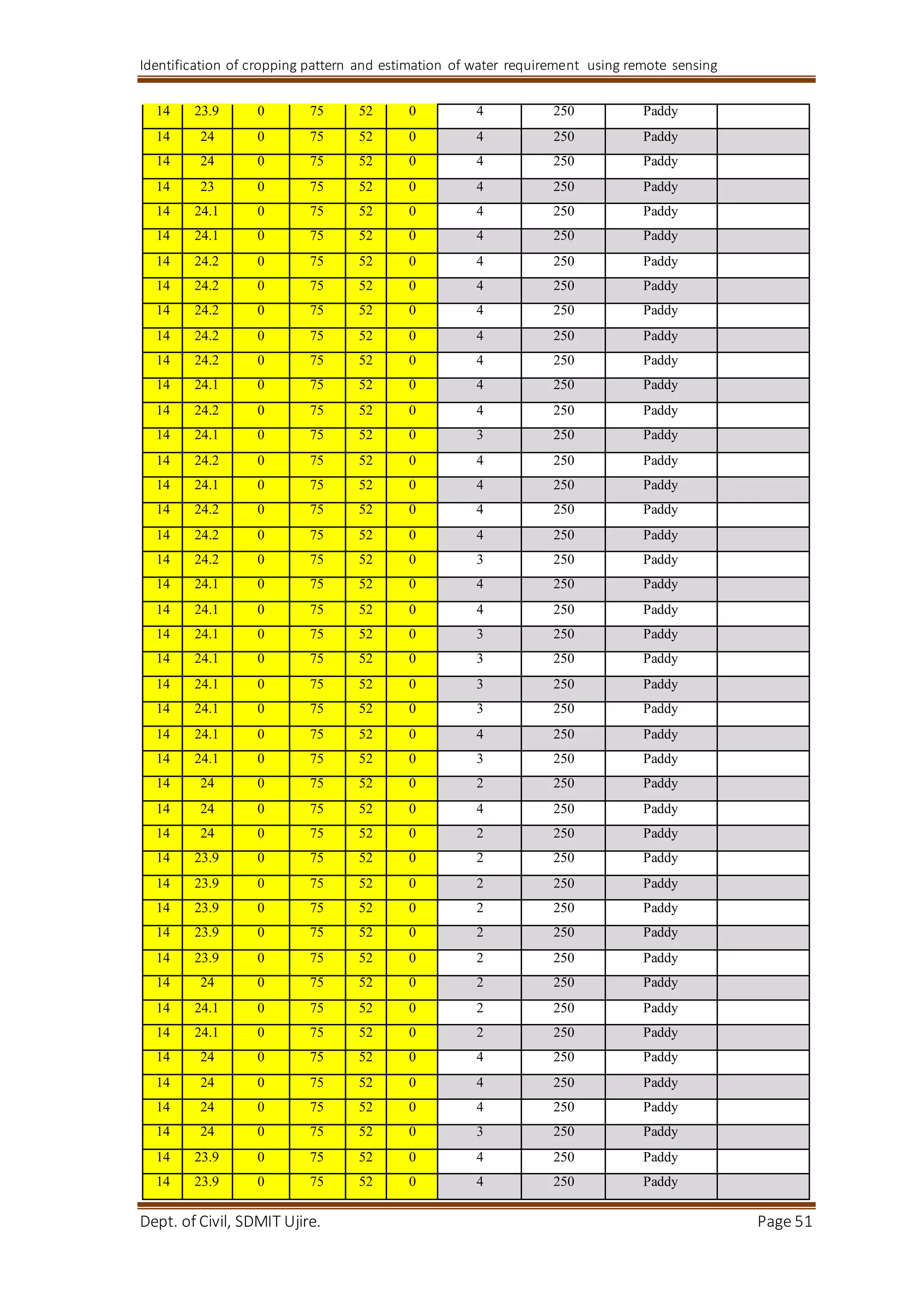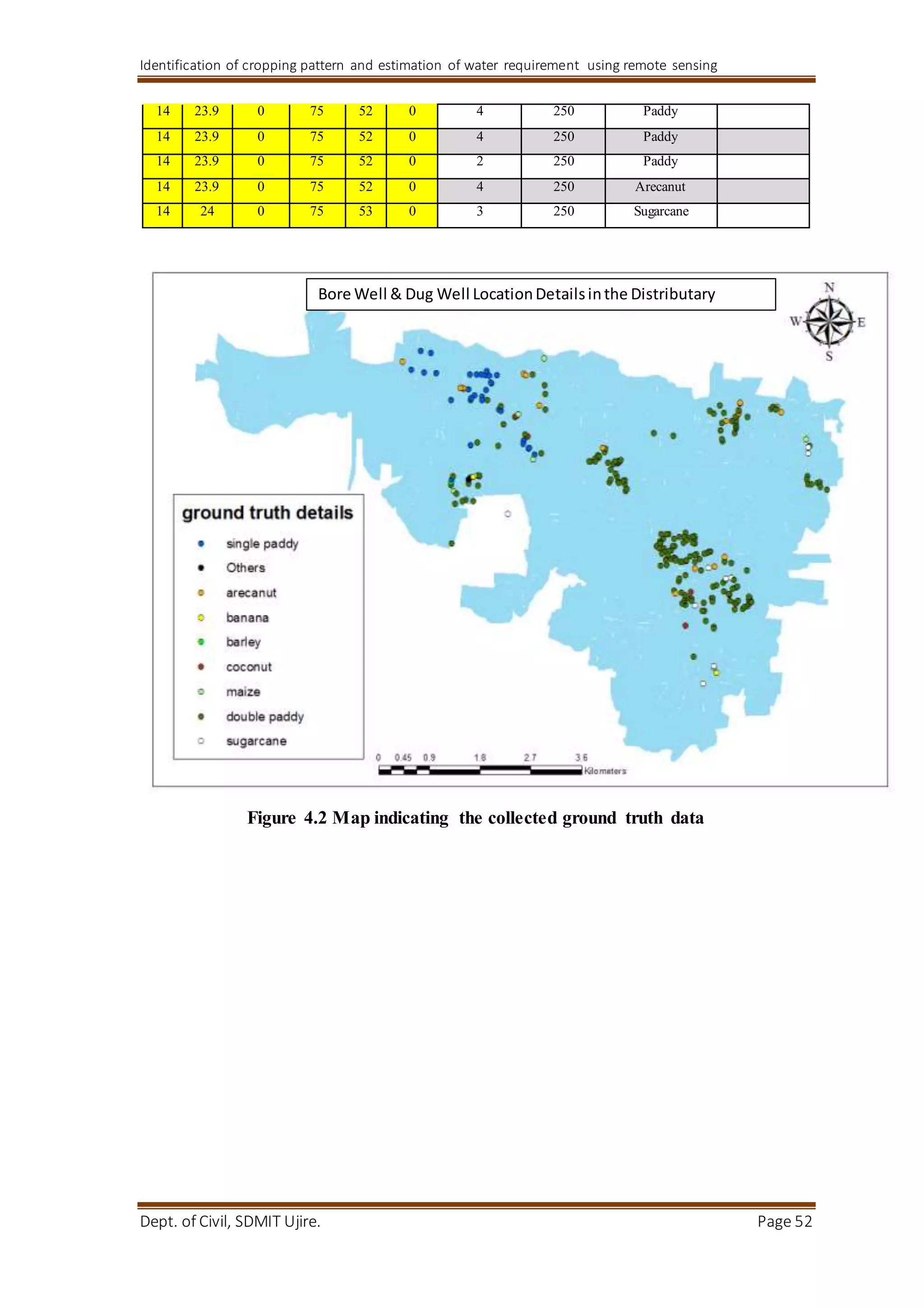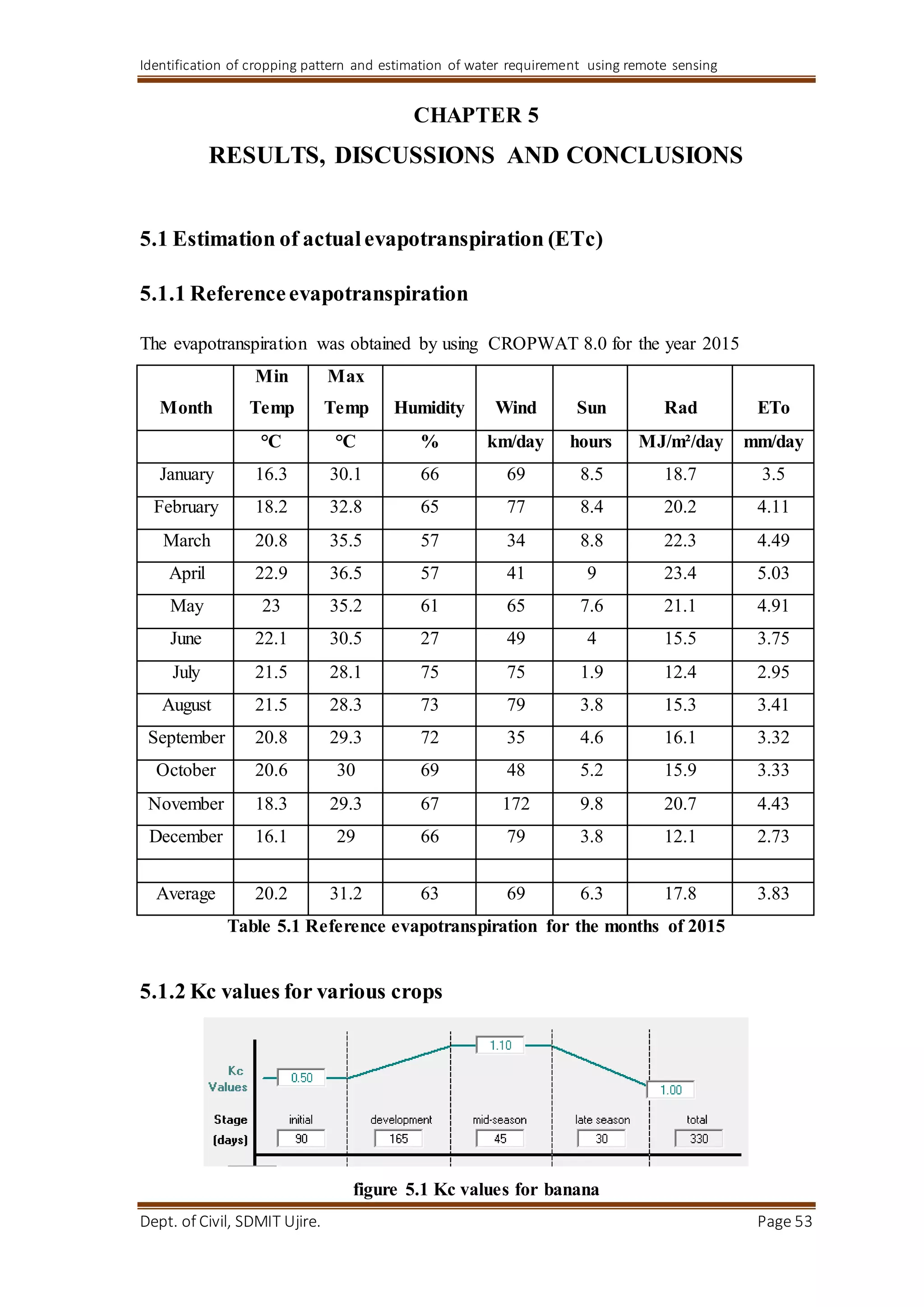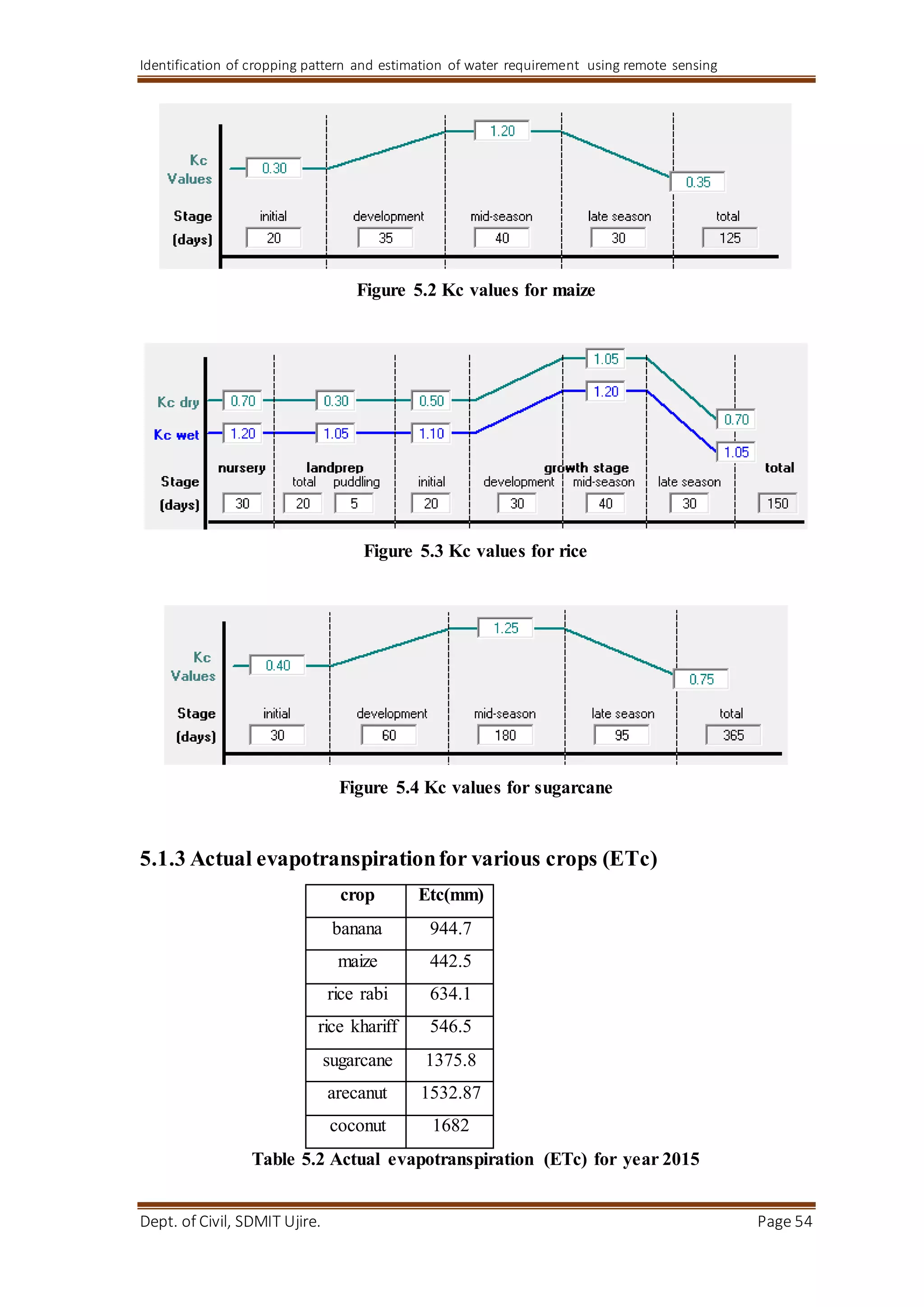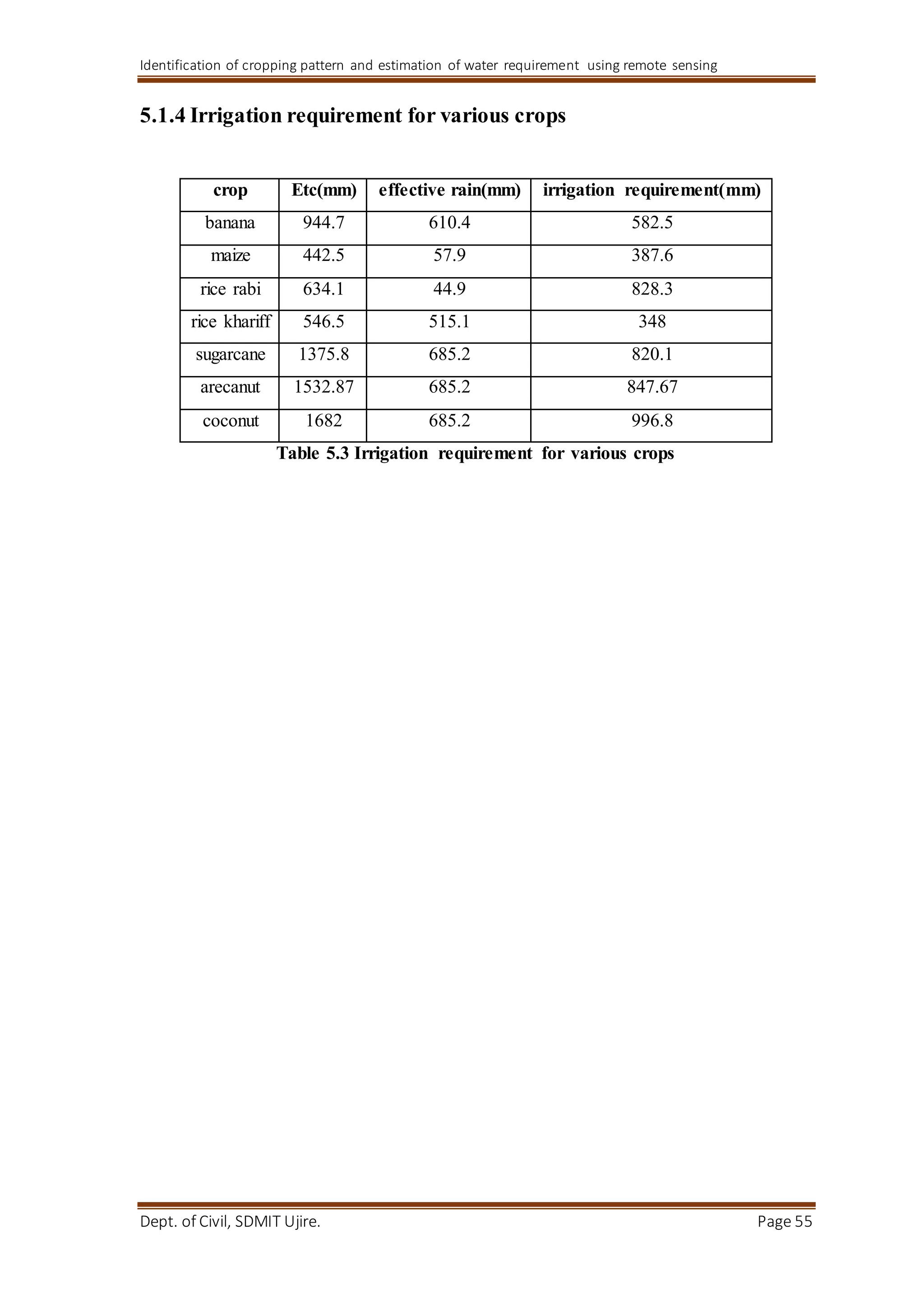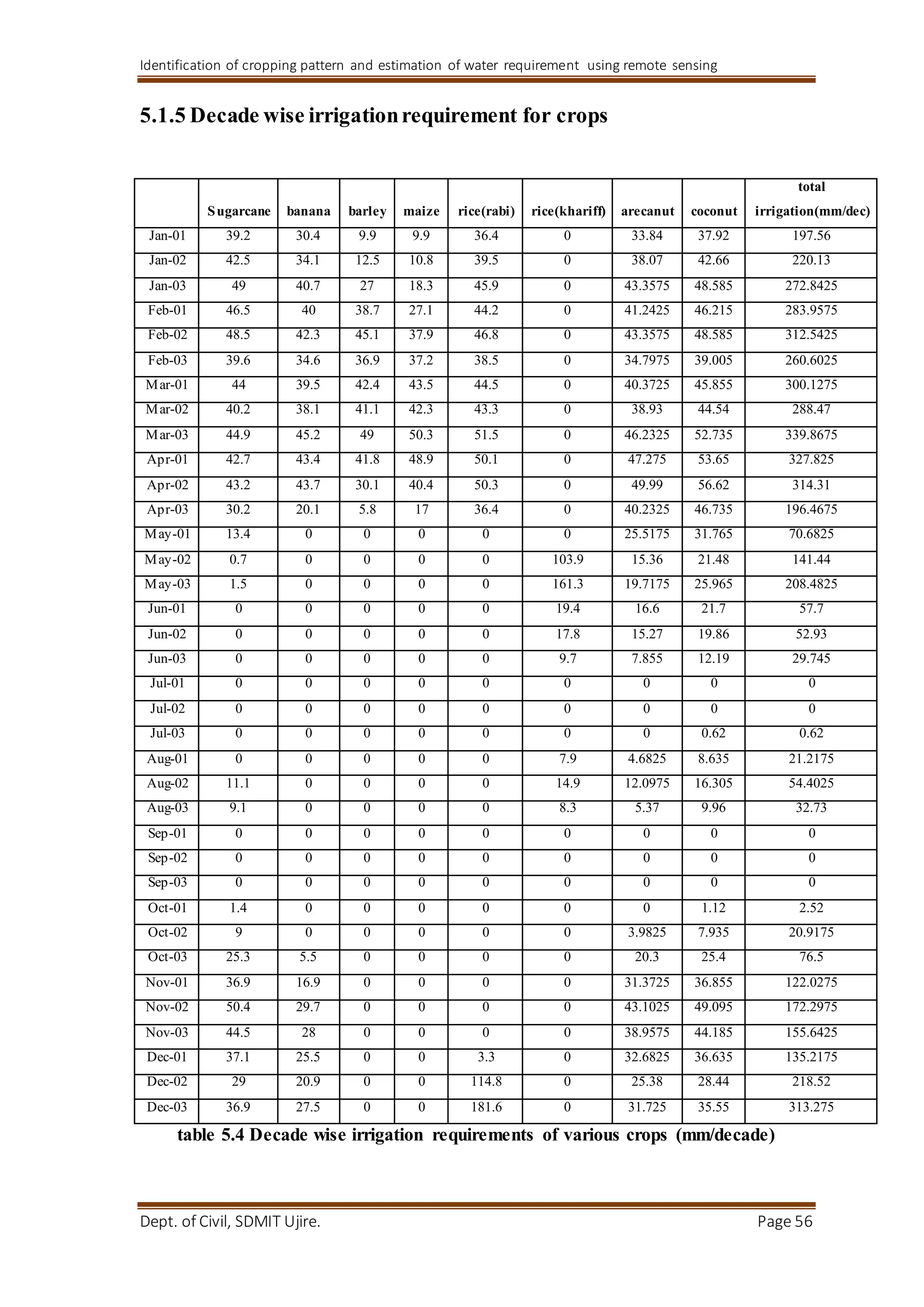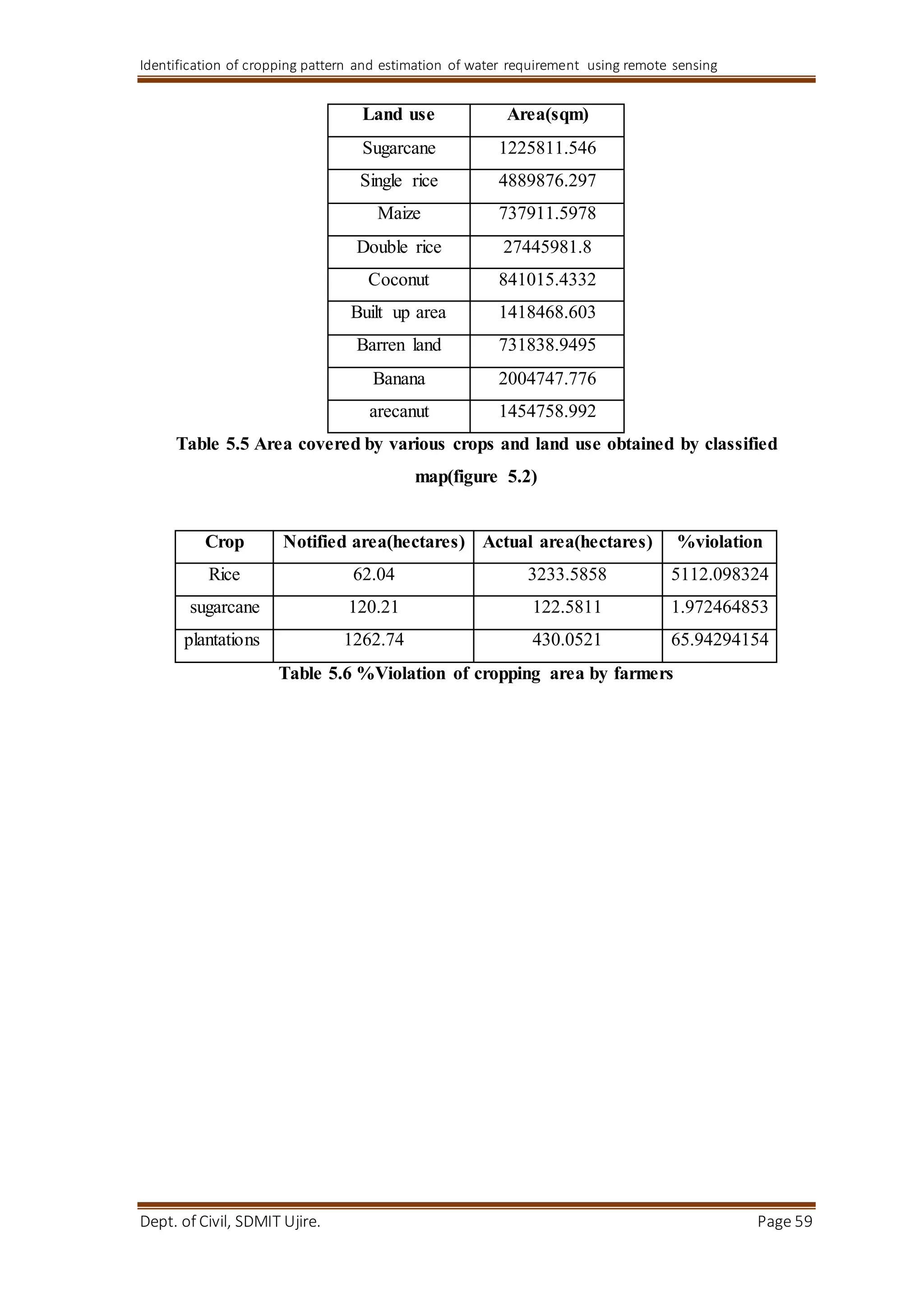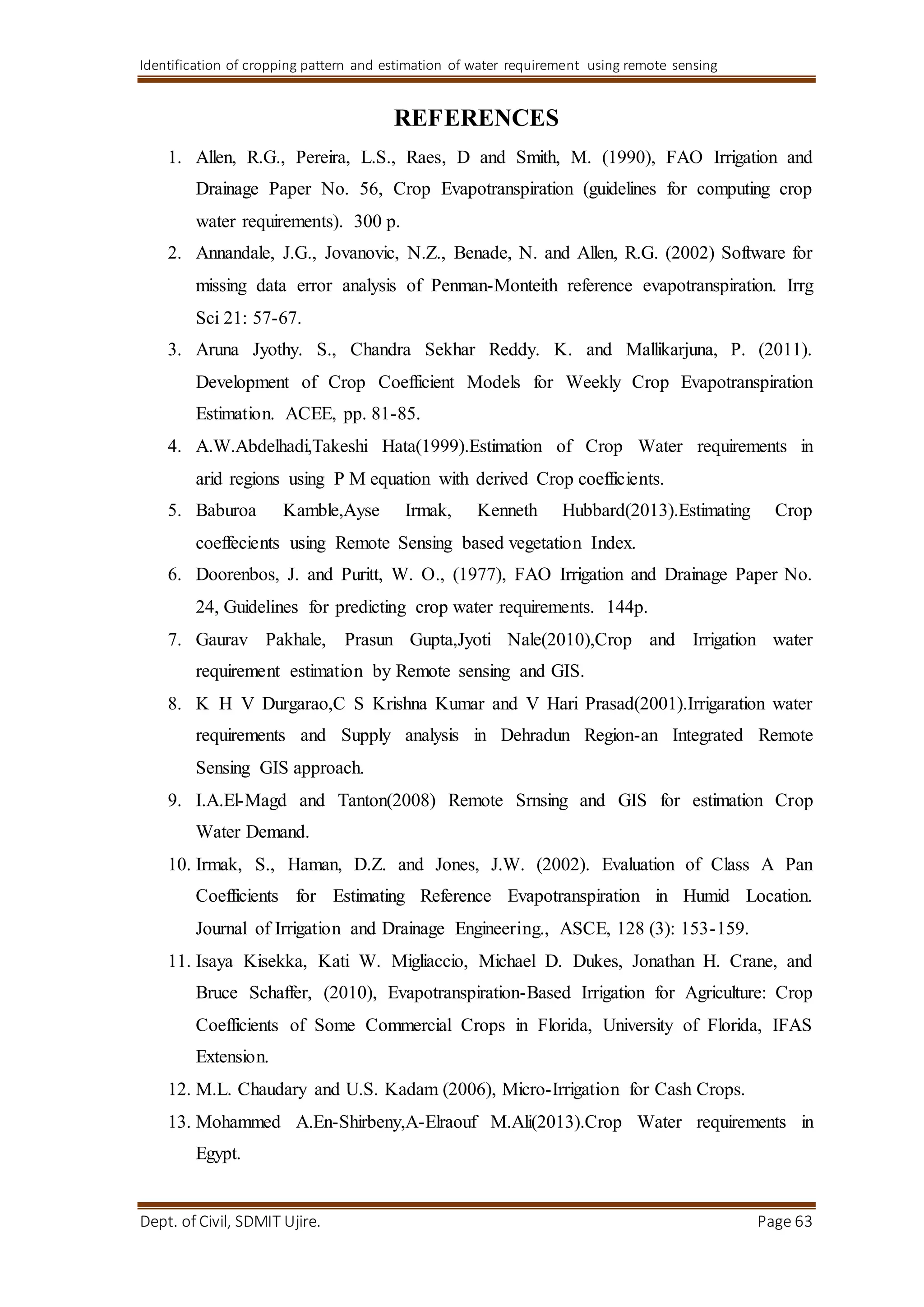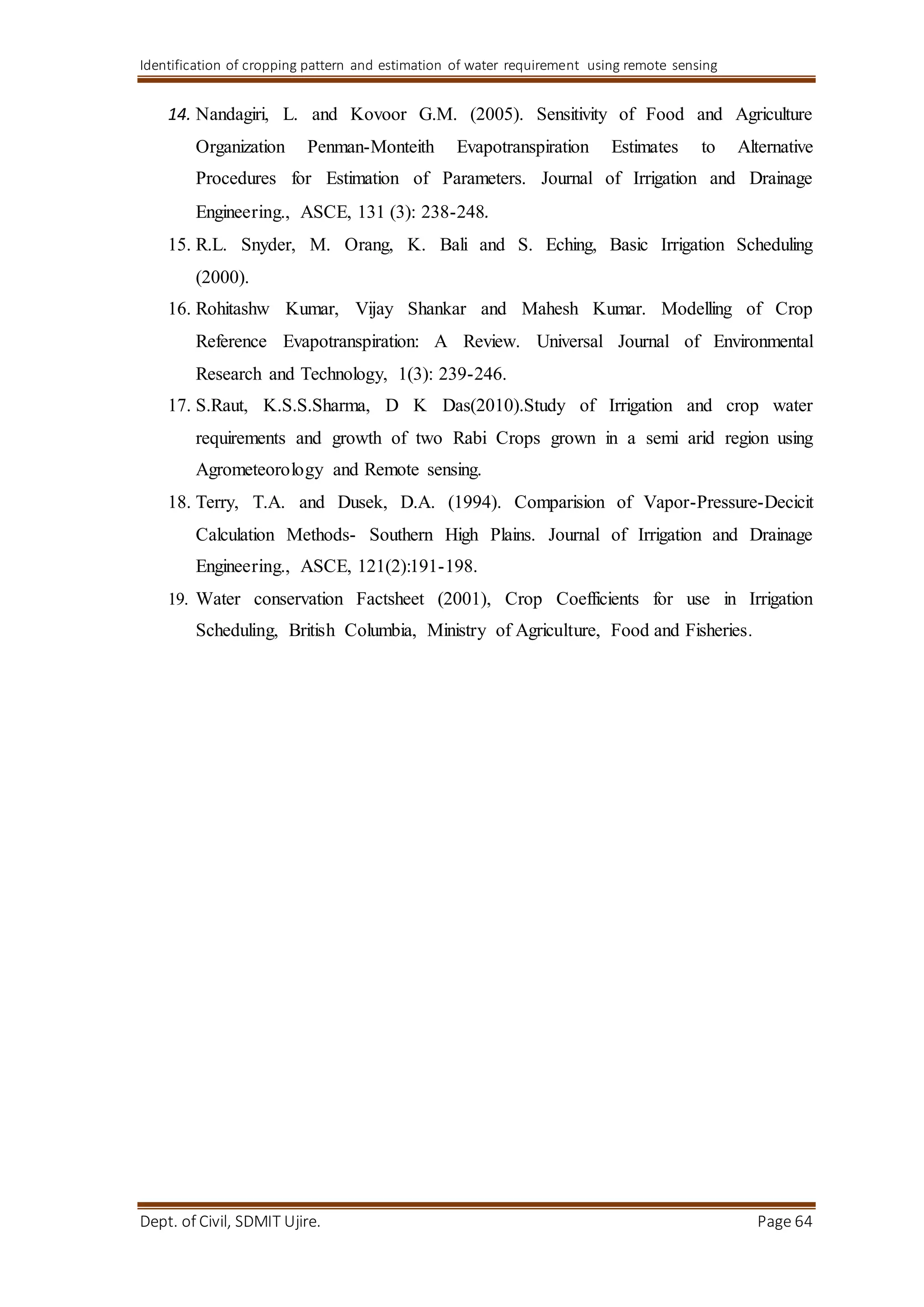The document discusses the increasing water requirements in agriculture, particularly in dry climates where water is scarce. It highlights irrigation scheduling as a technique to optimize water use efficiency while considering factors such as evapotranspiration, soil water content, and crop management. The study aims to estimate crop water requirements for various crops and generate cropping pattern maps using remote sensing techniques.
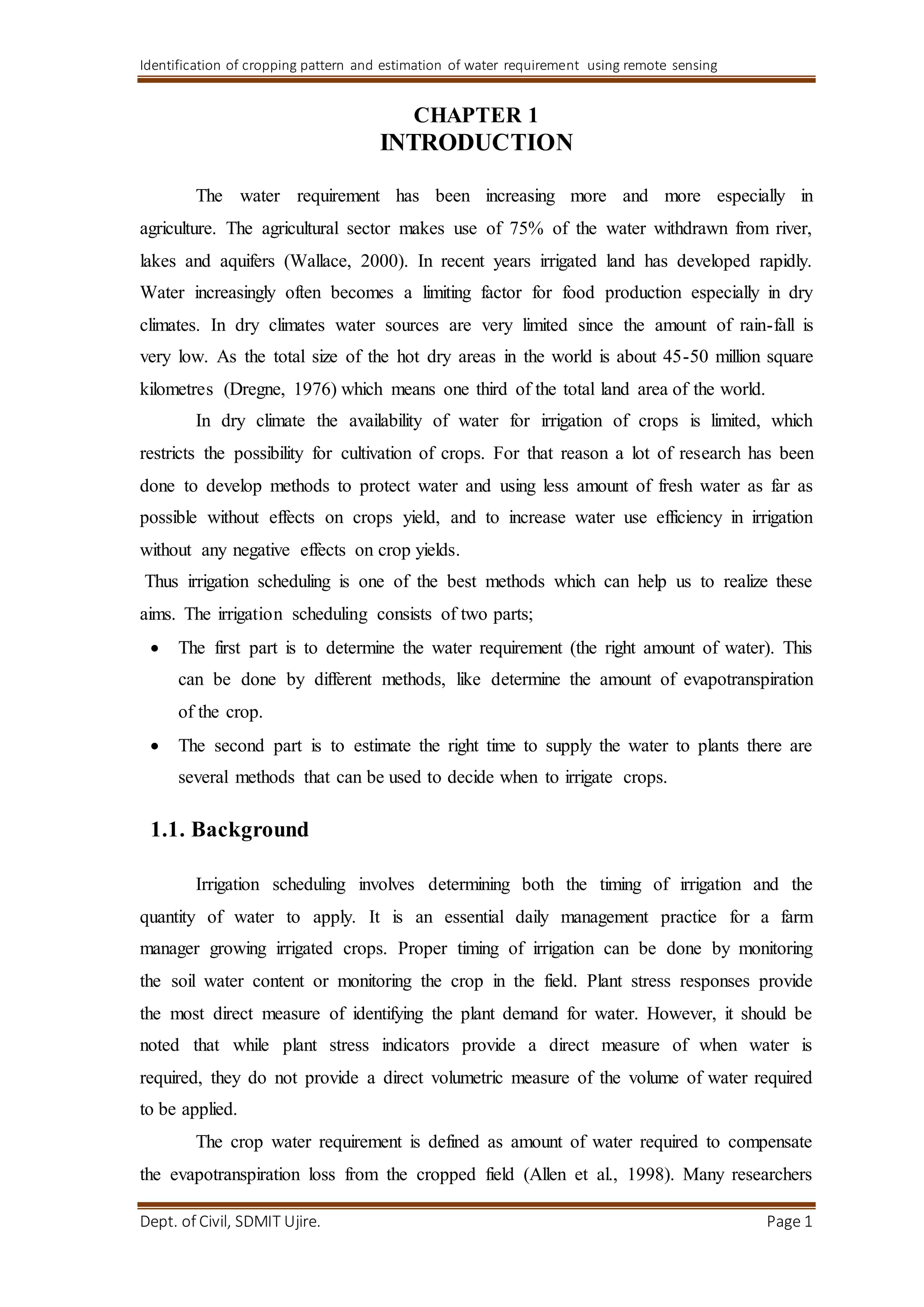
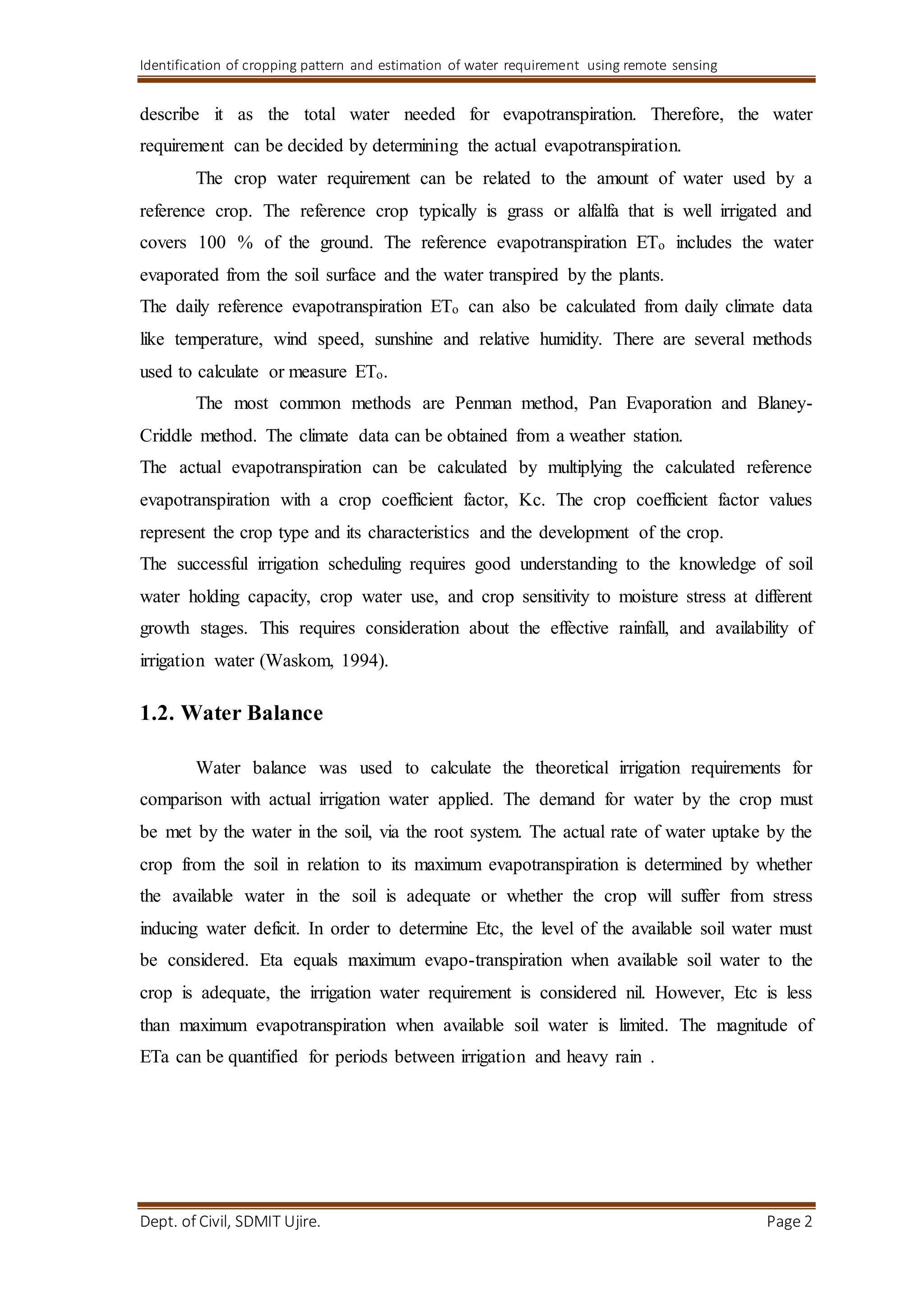
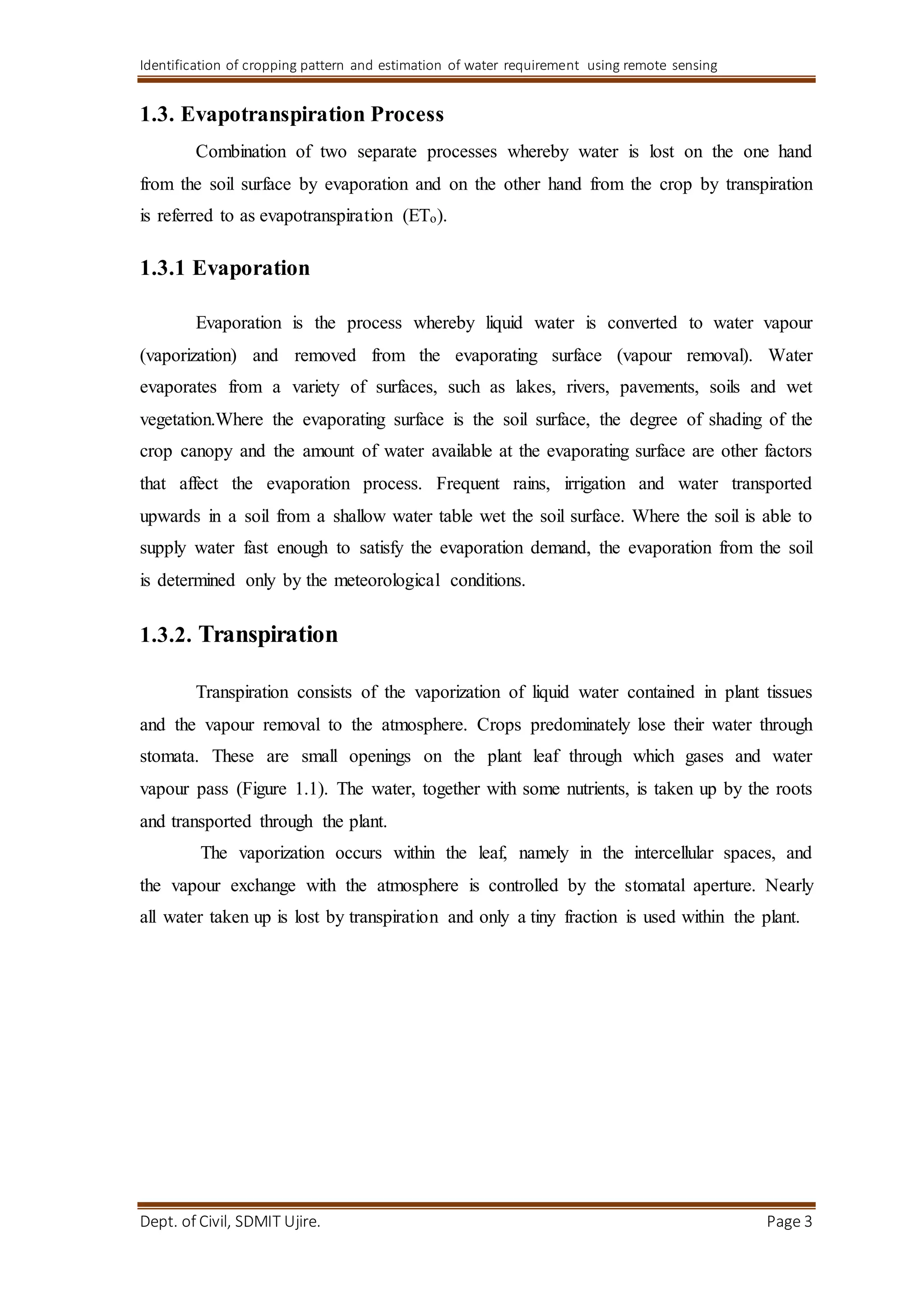
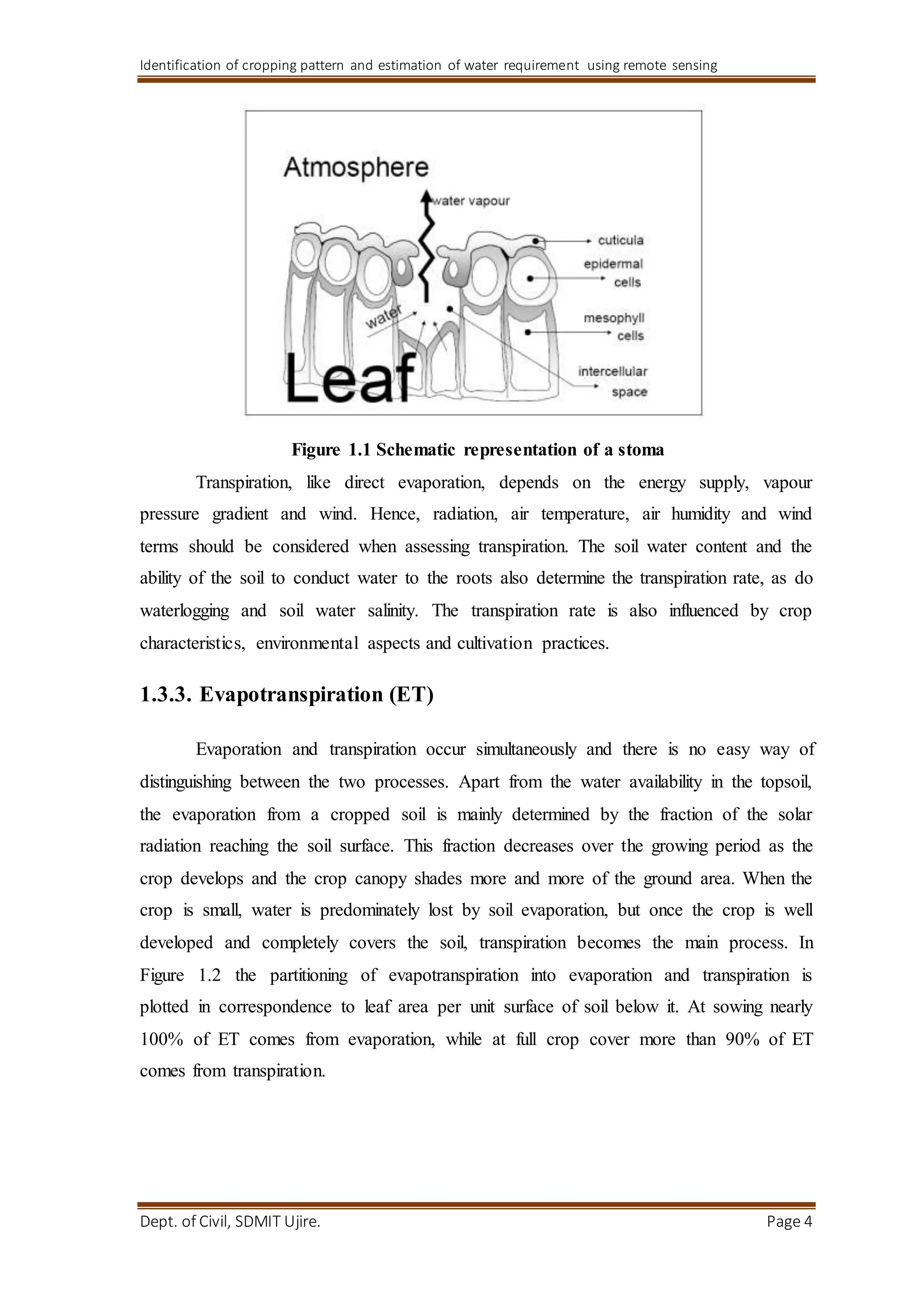
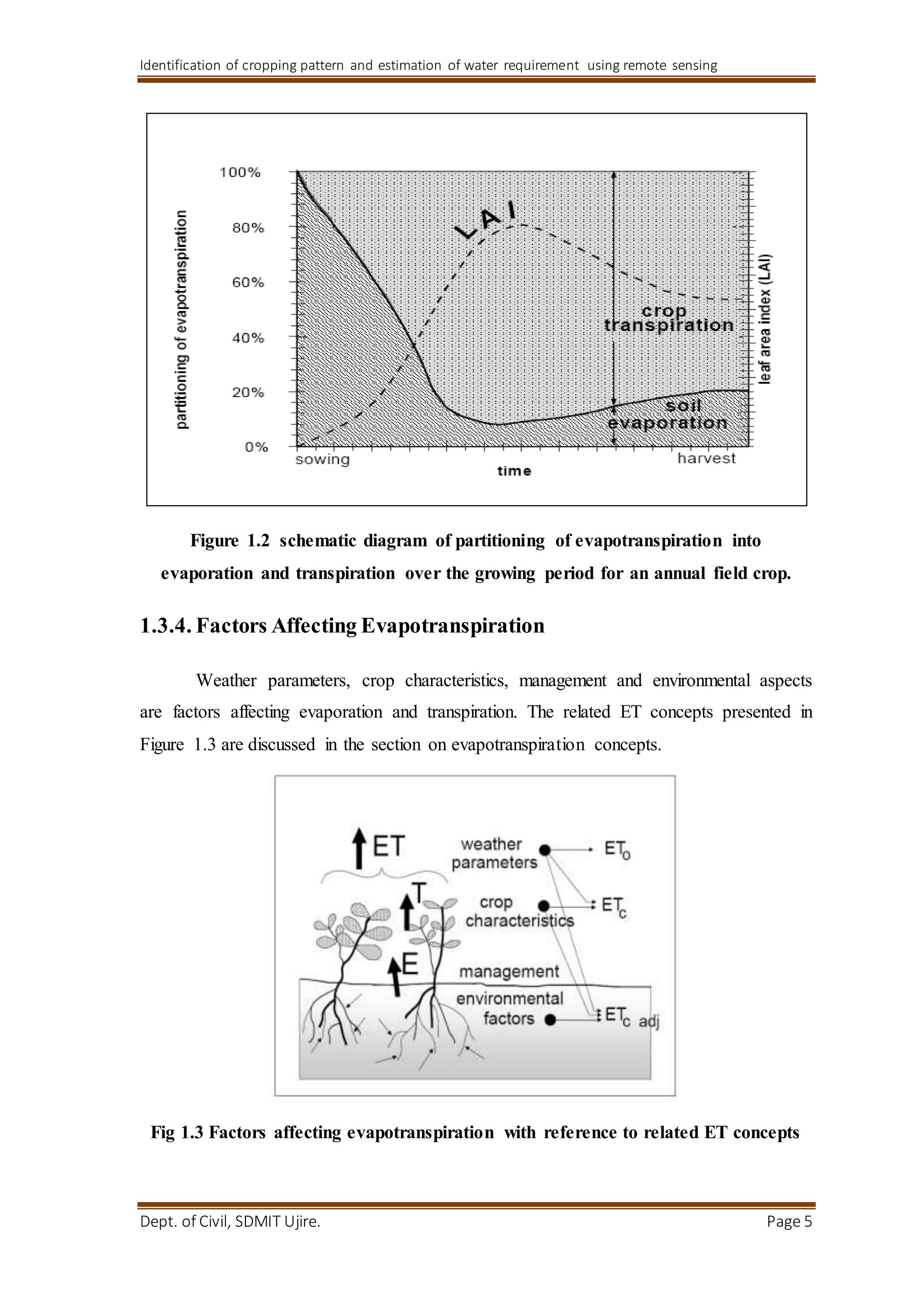
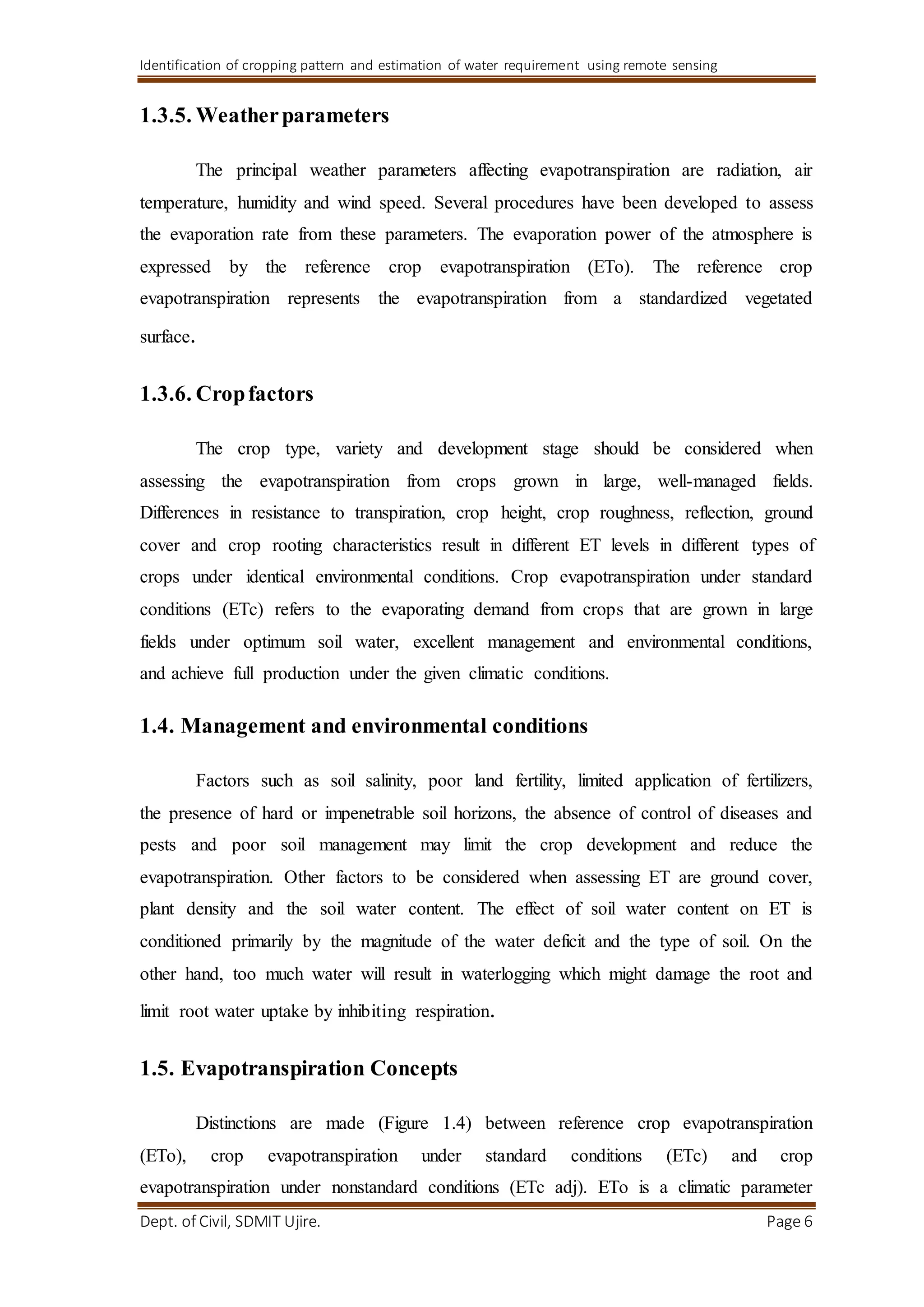
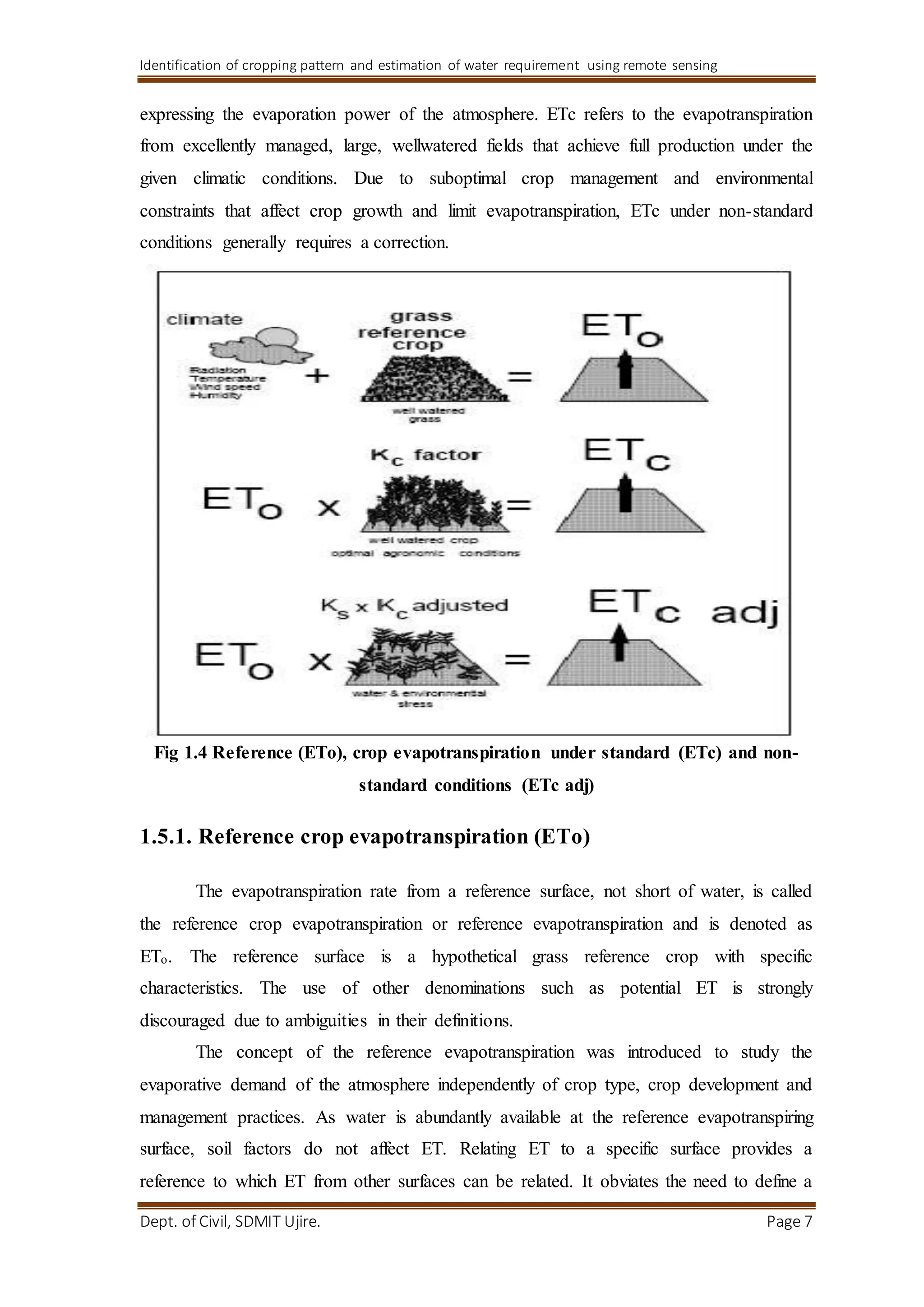
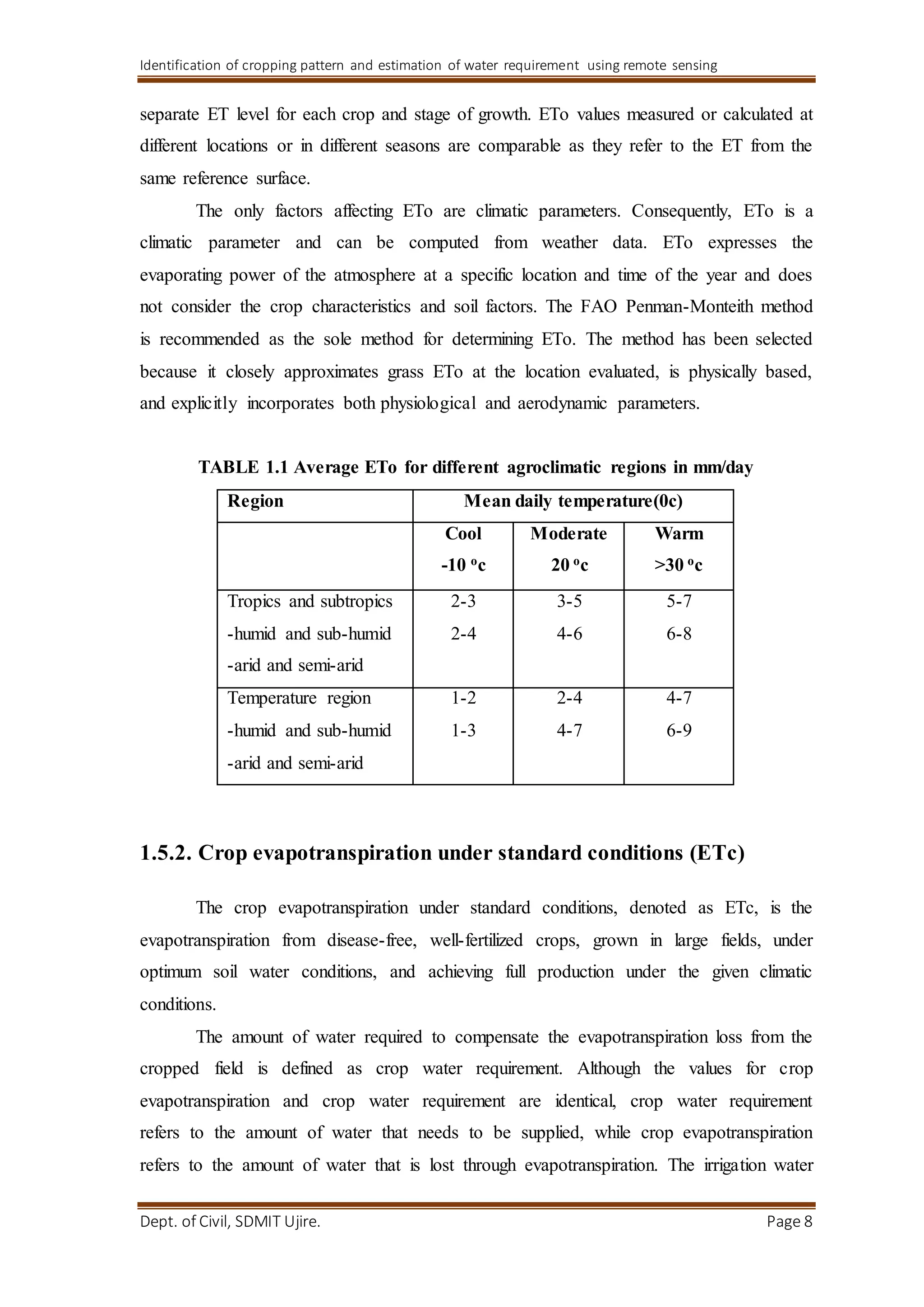
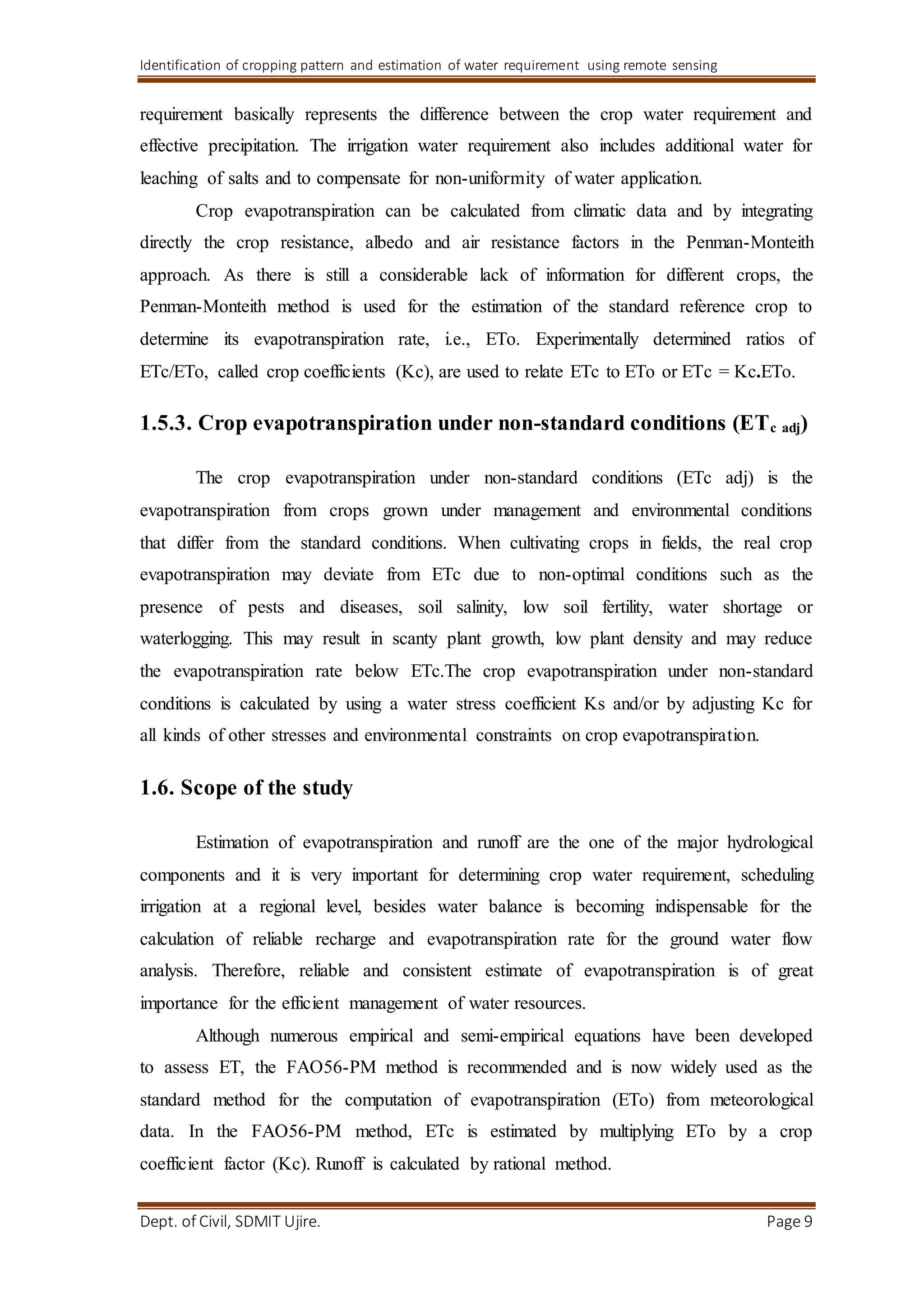

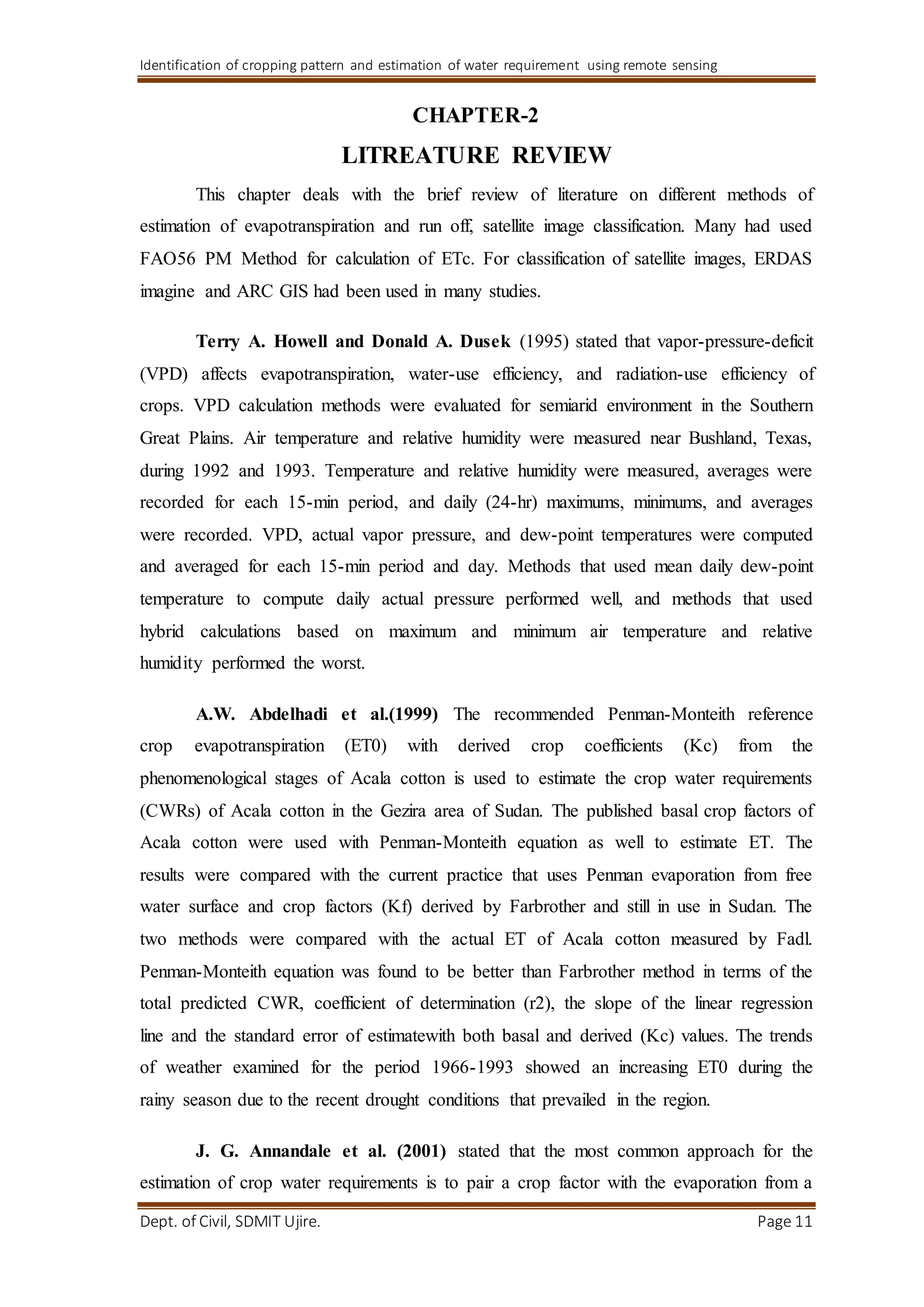
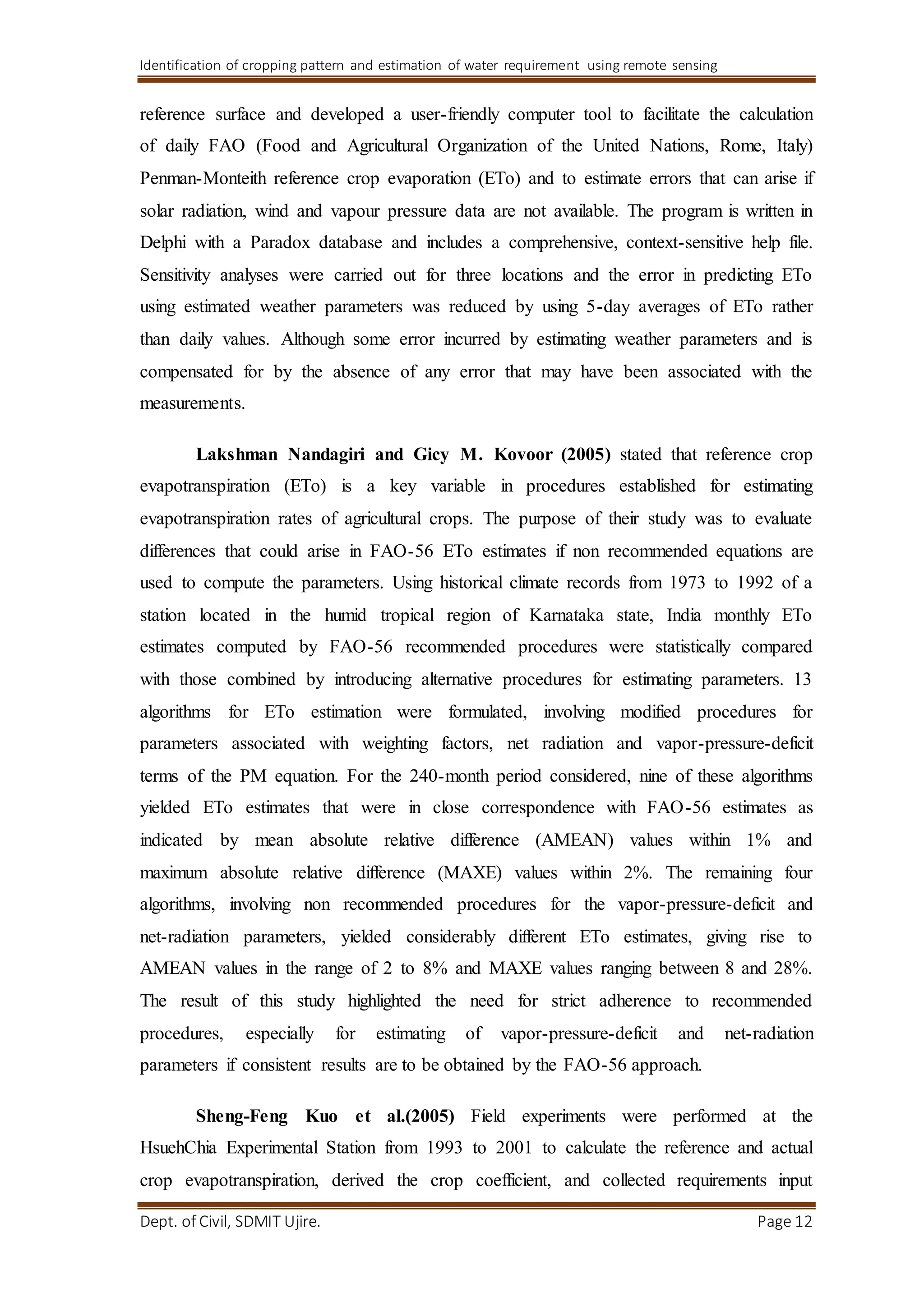


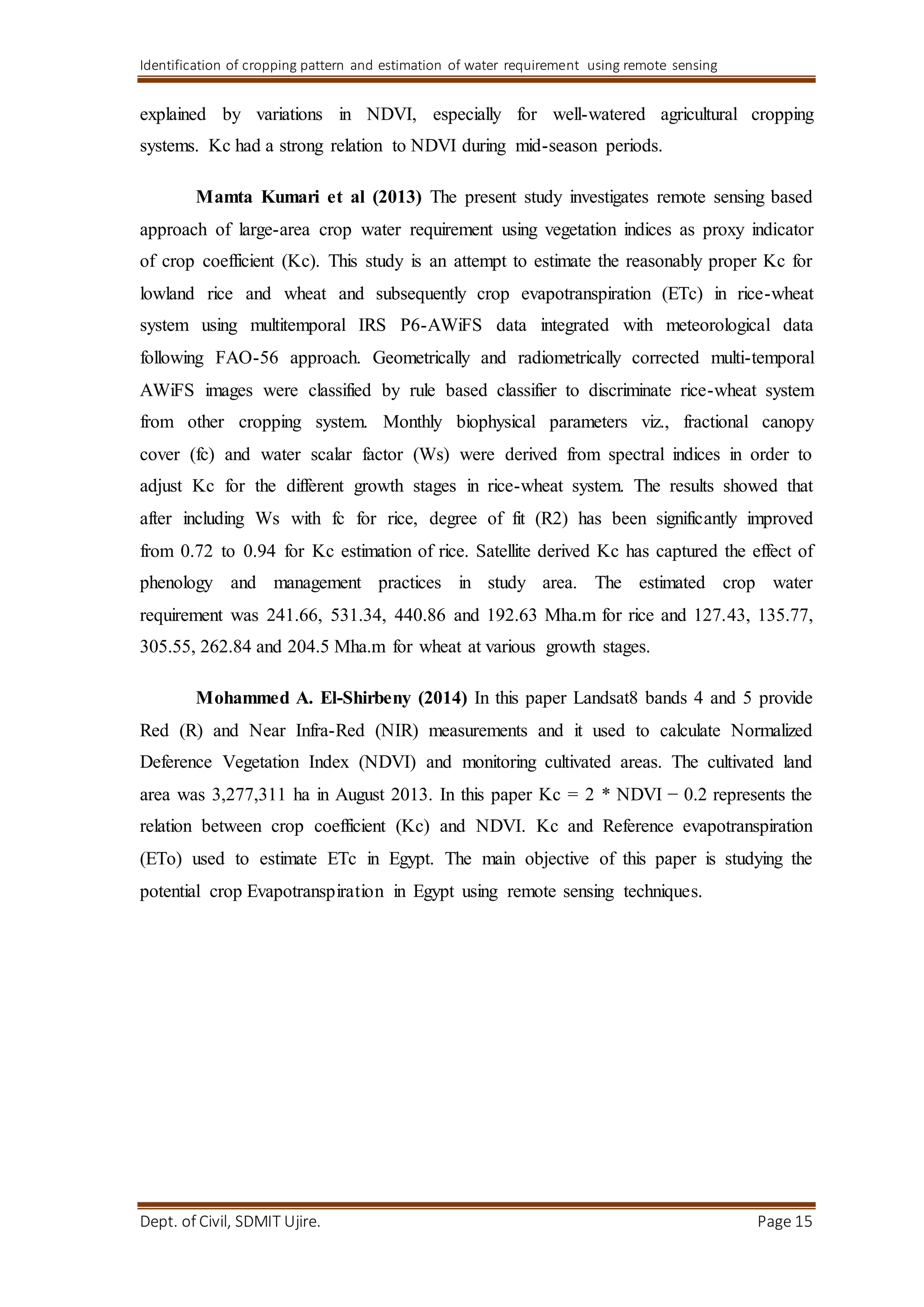
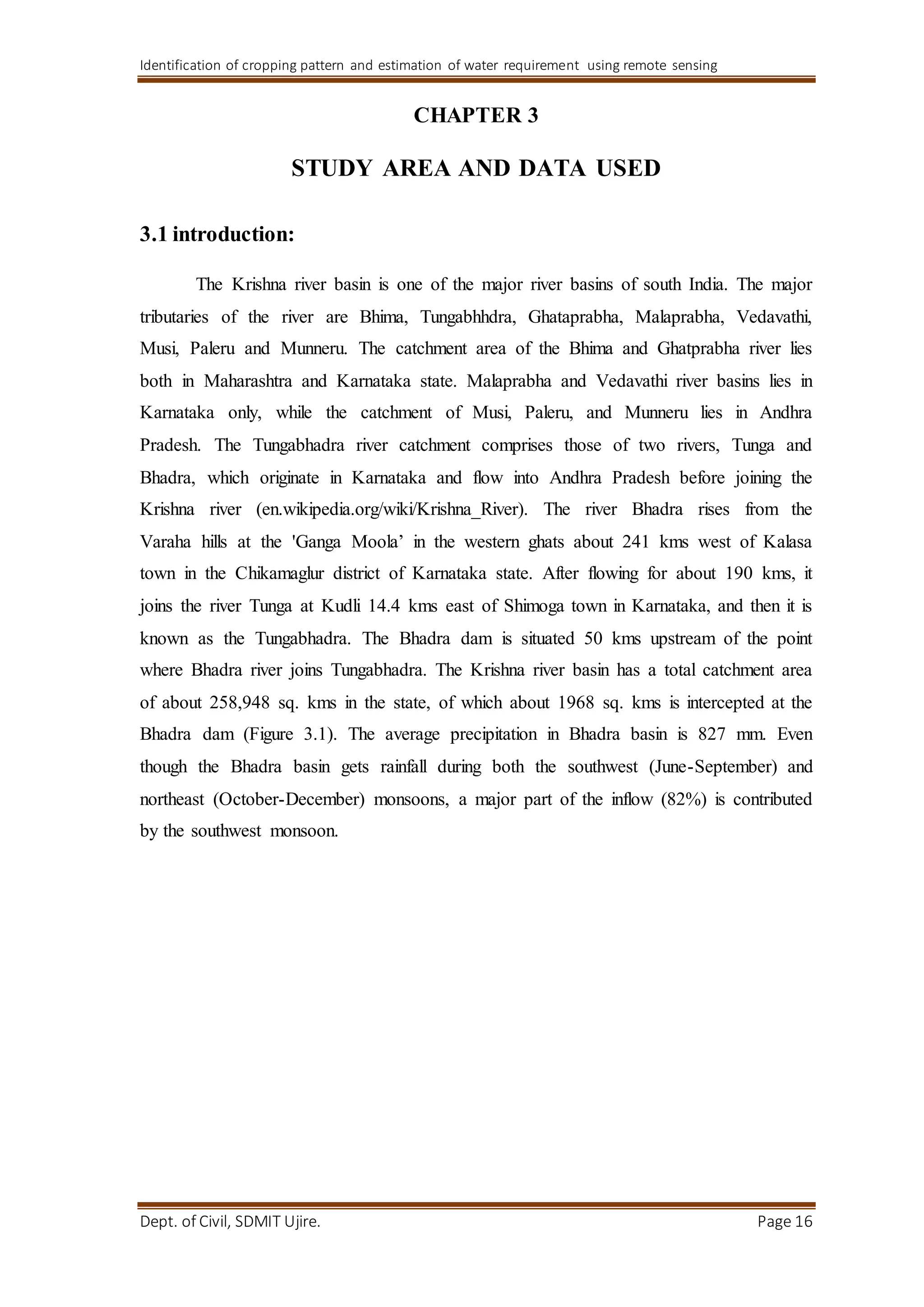
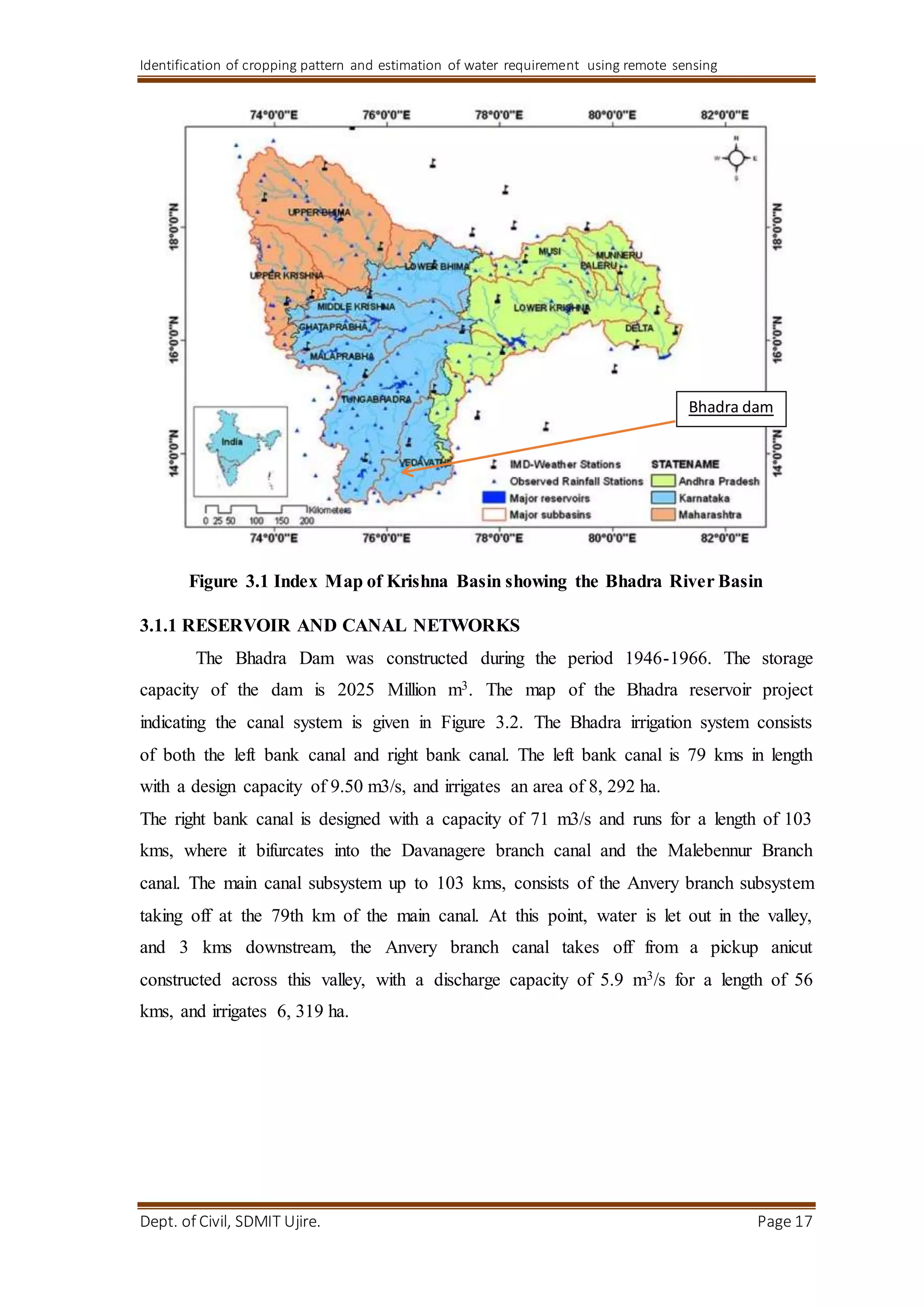
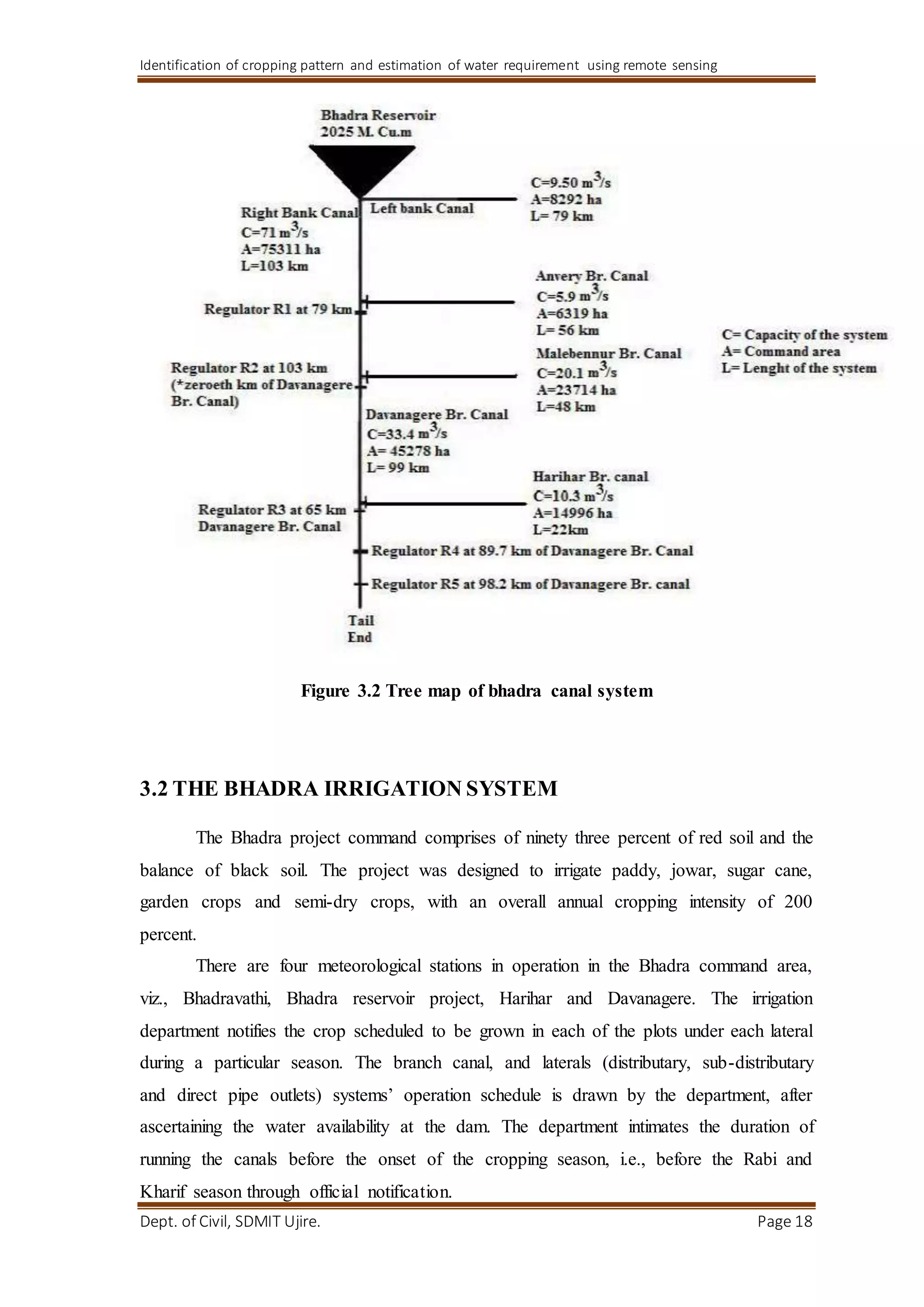
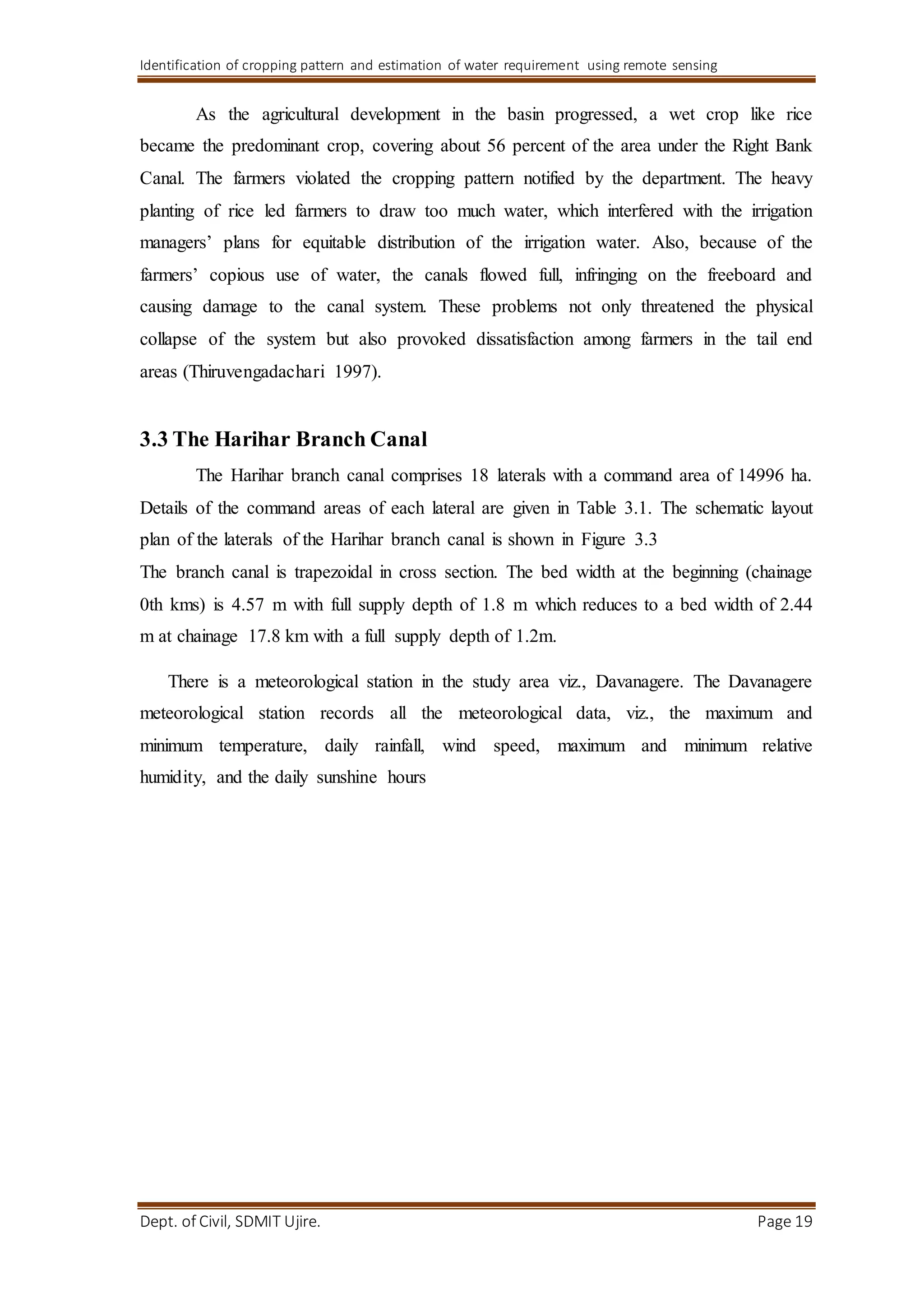
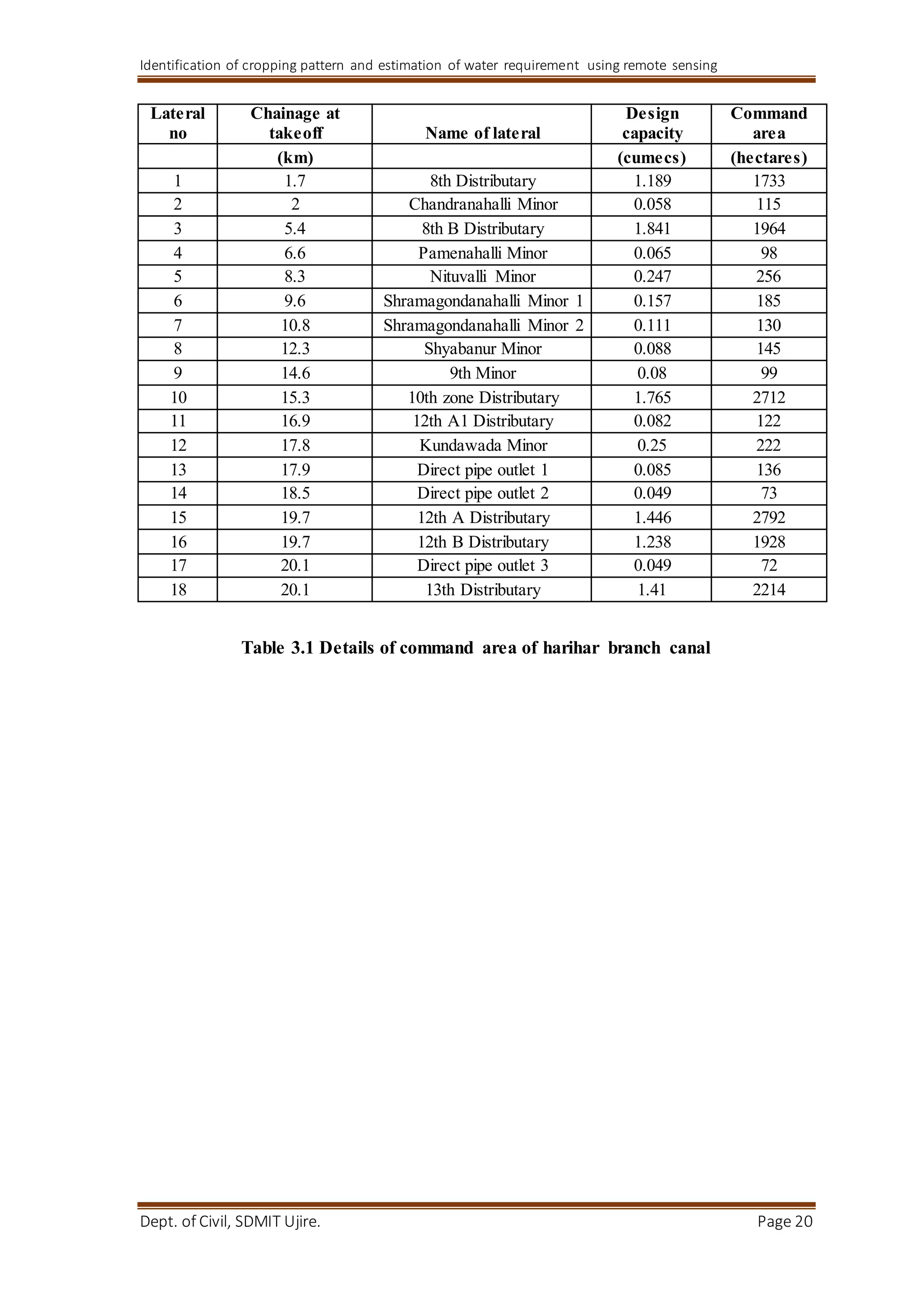
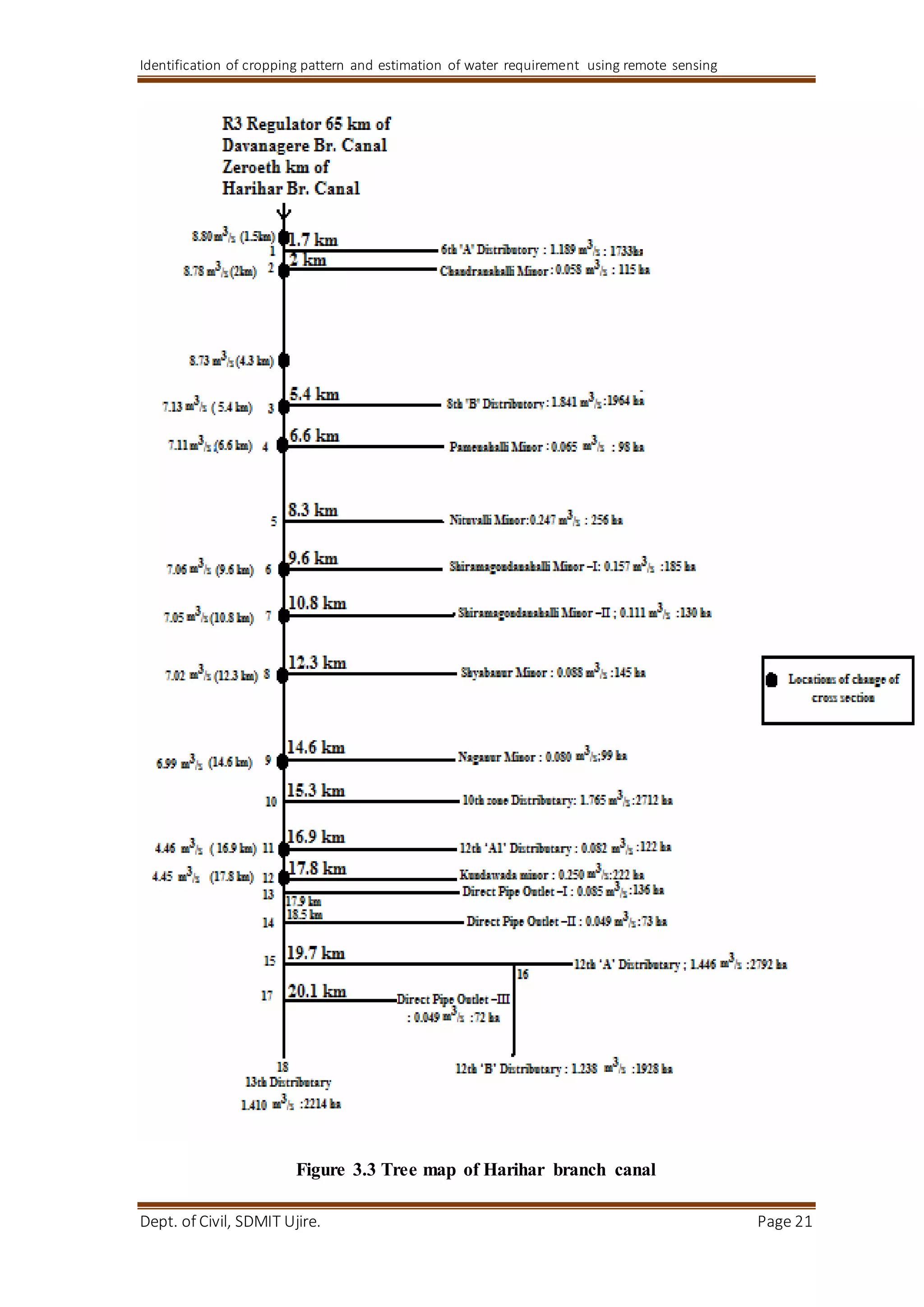
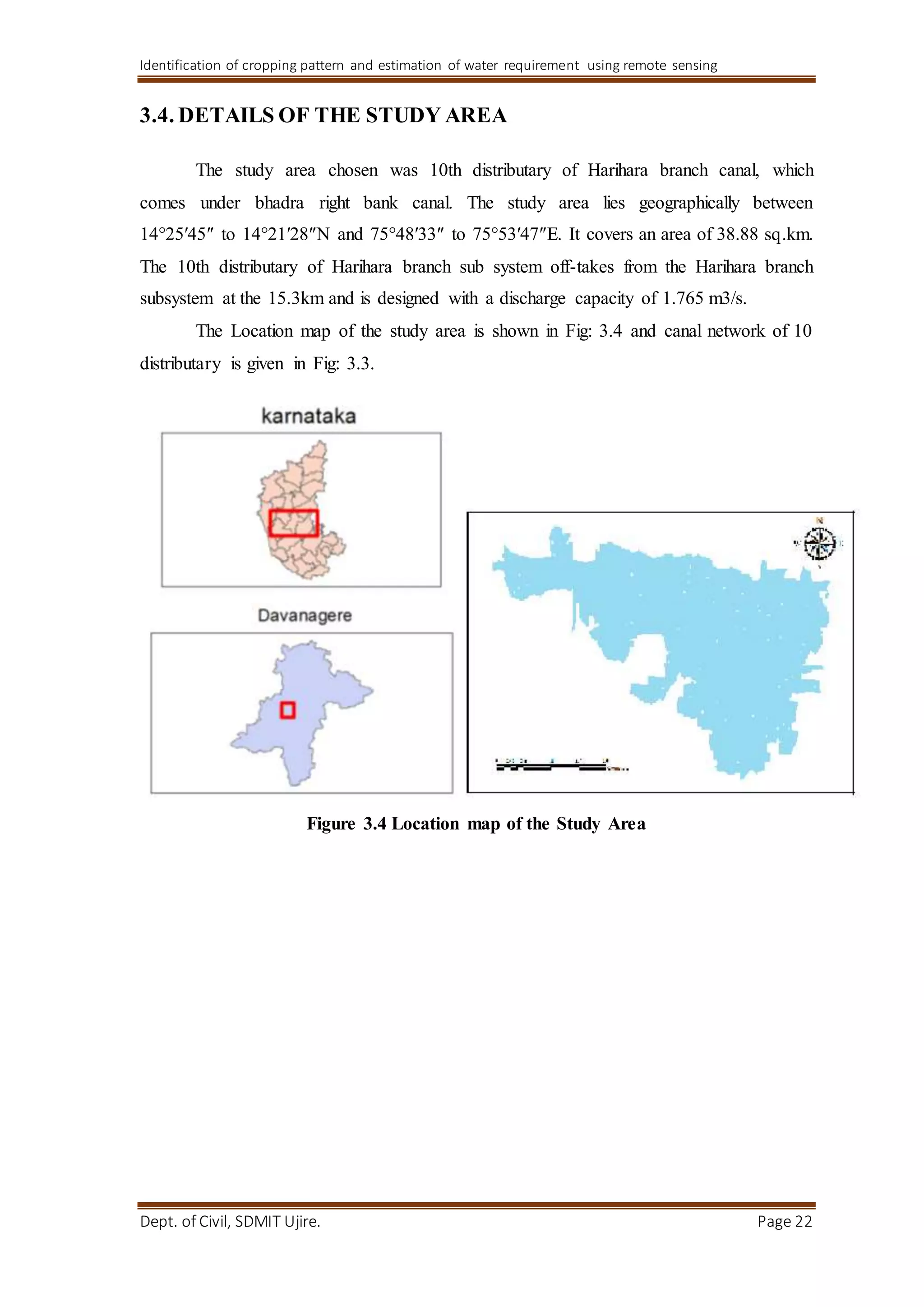
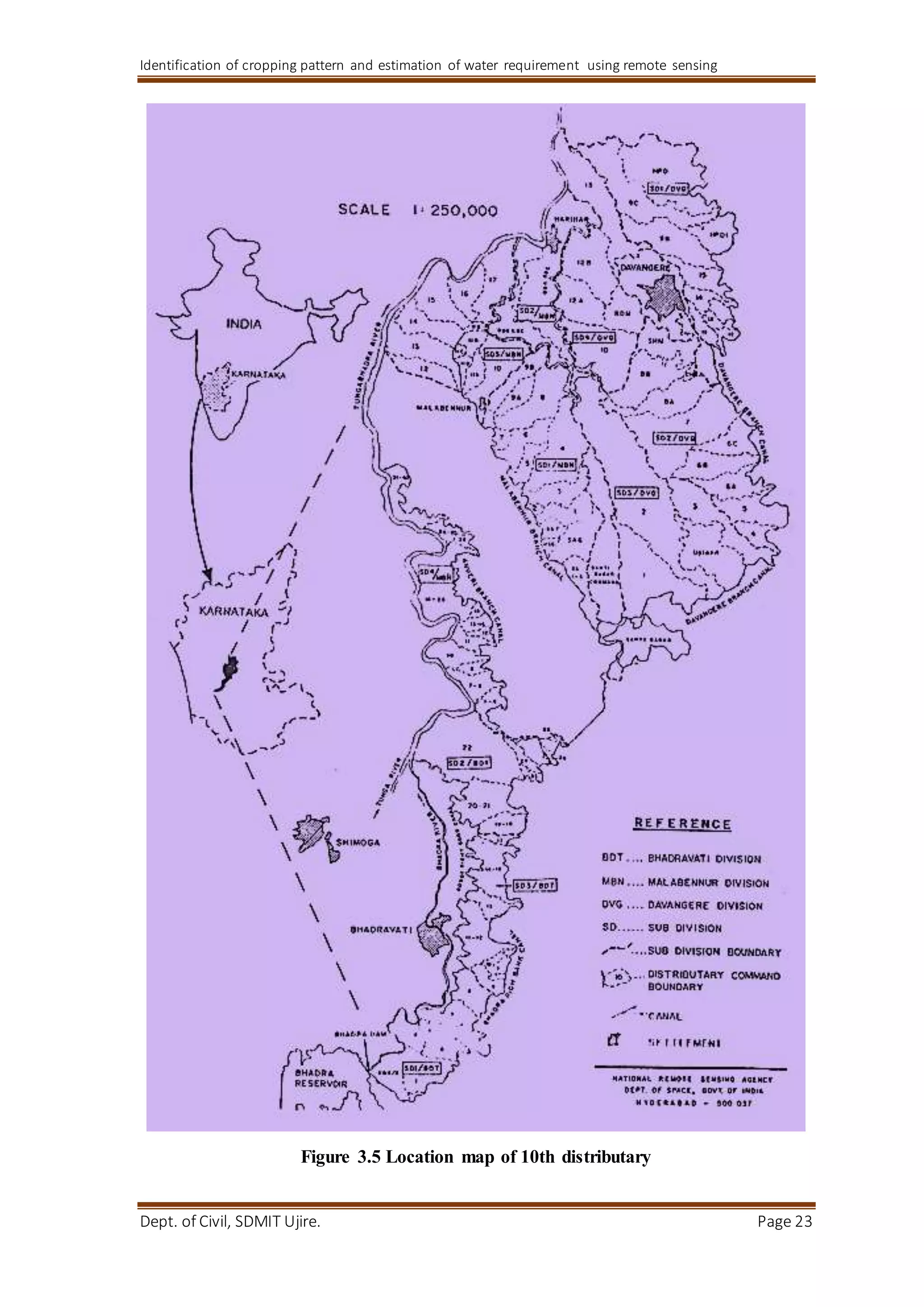
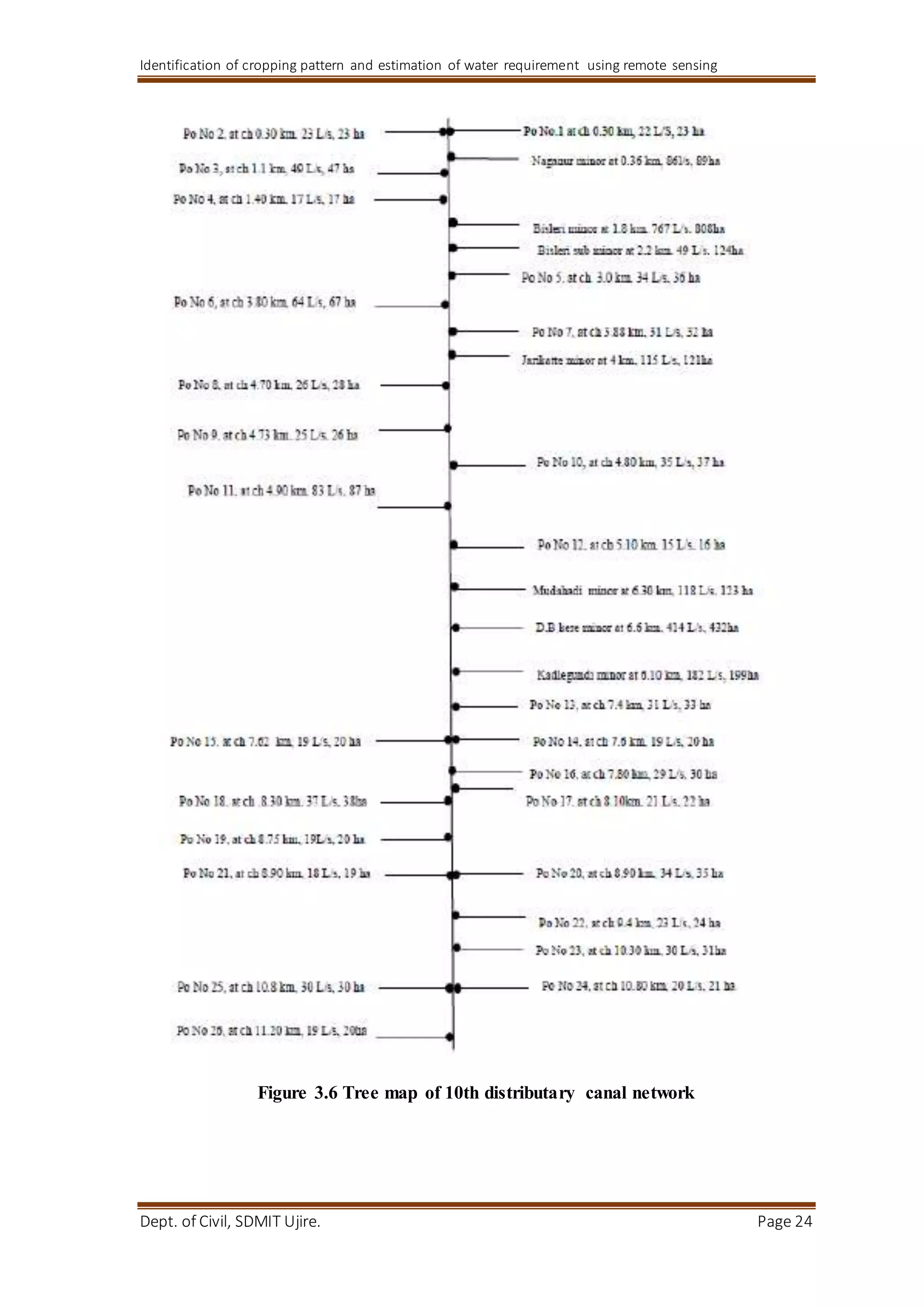

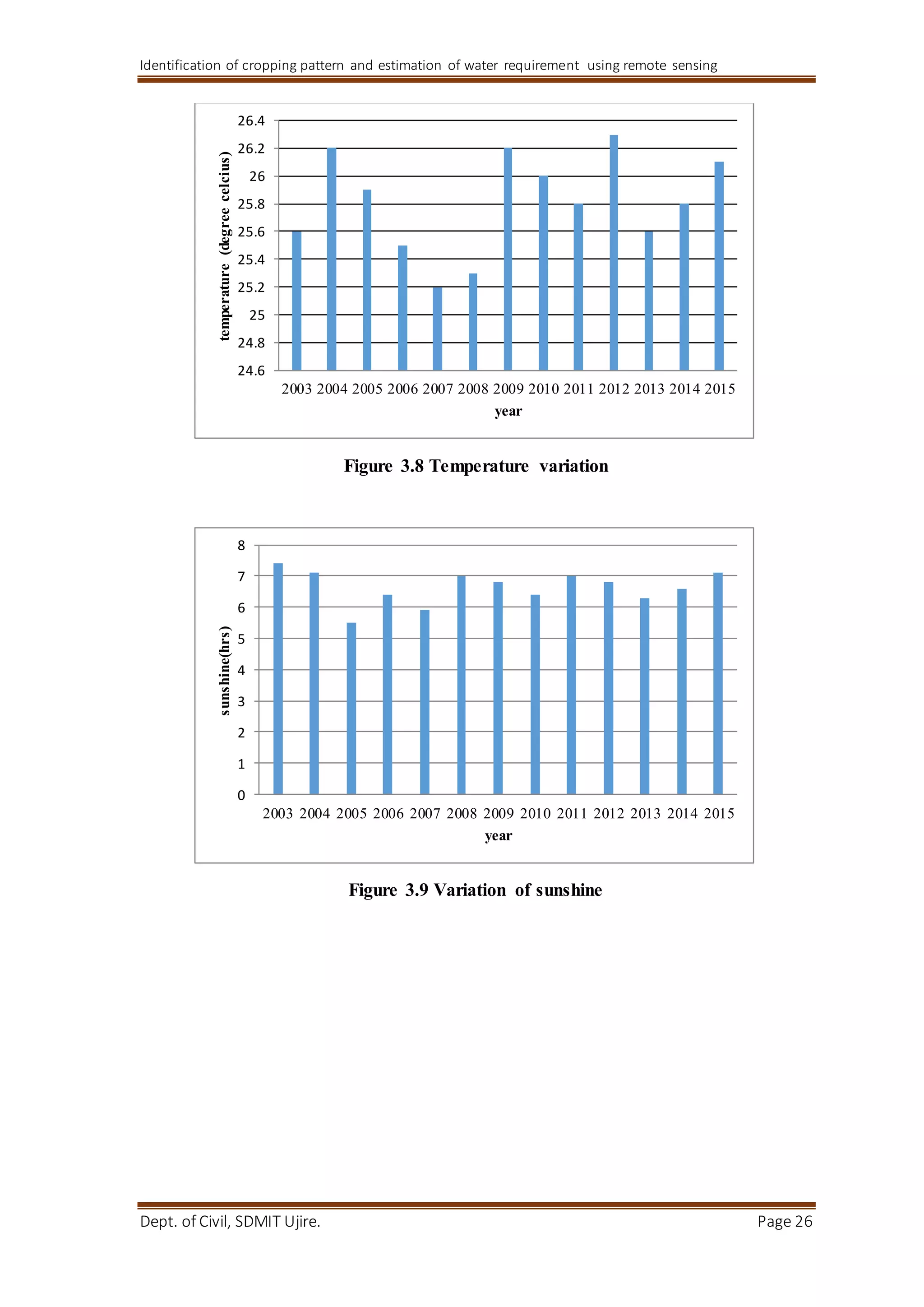
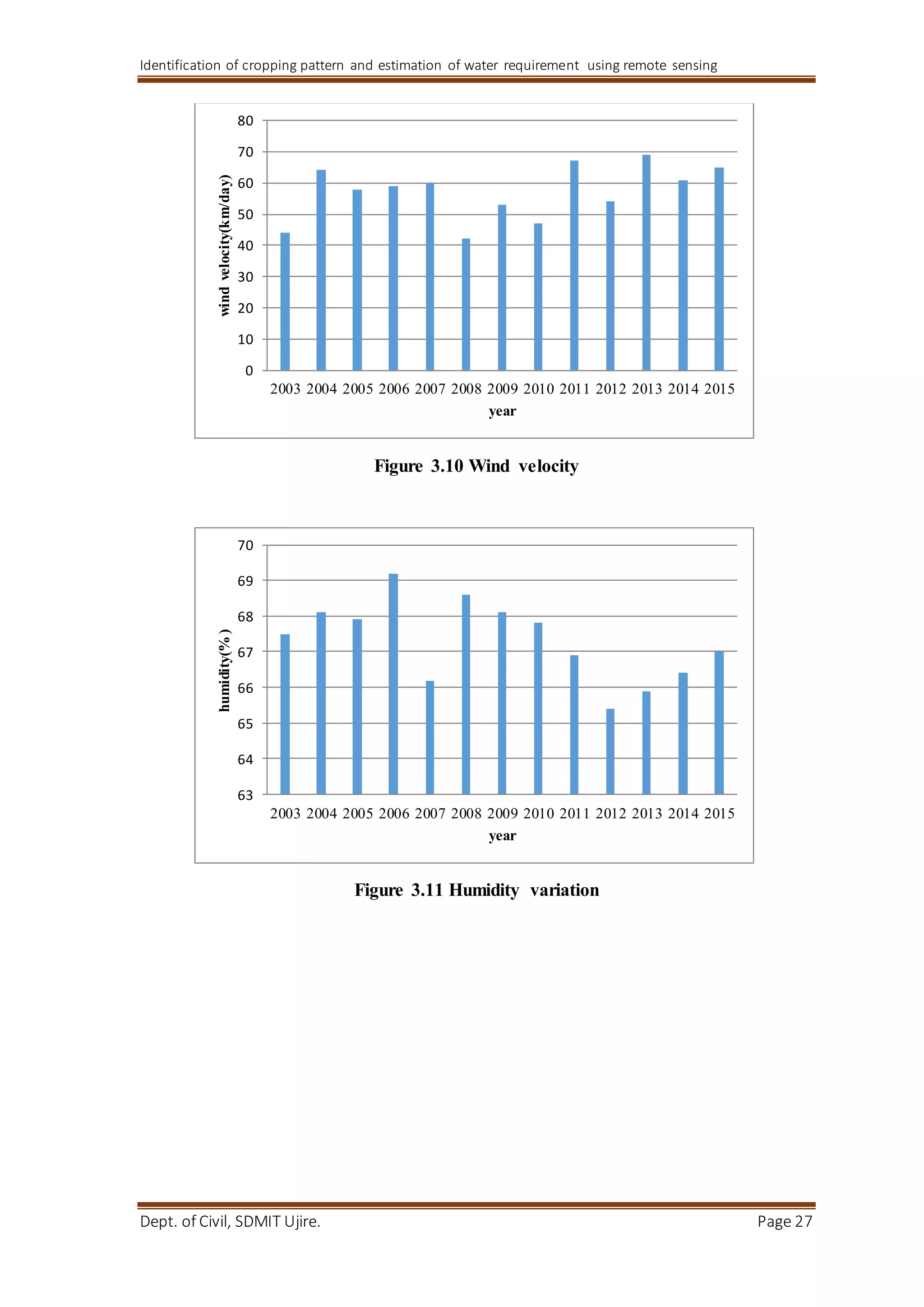
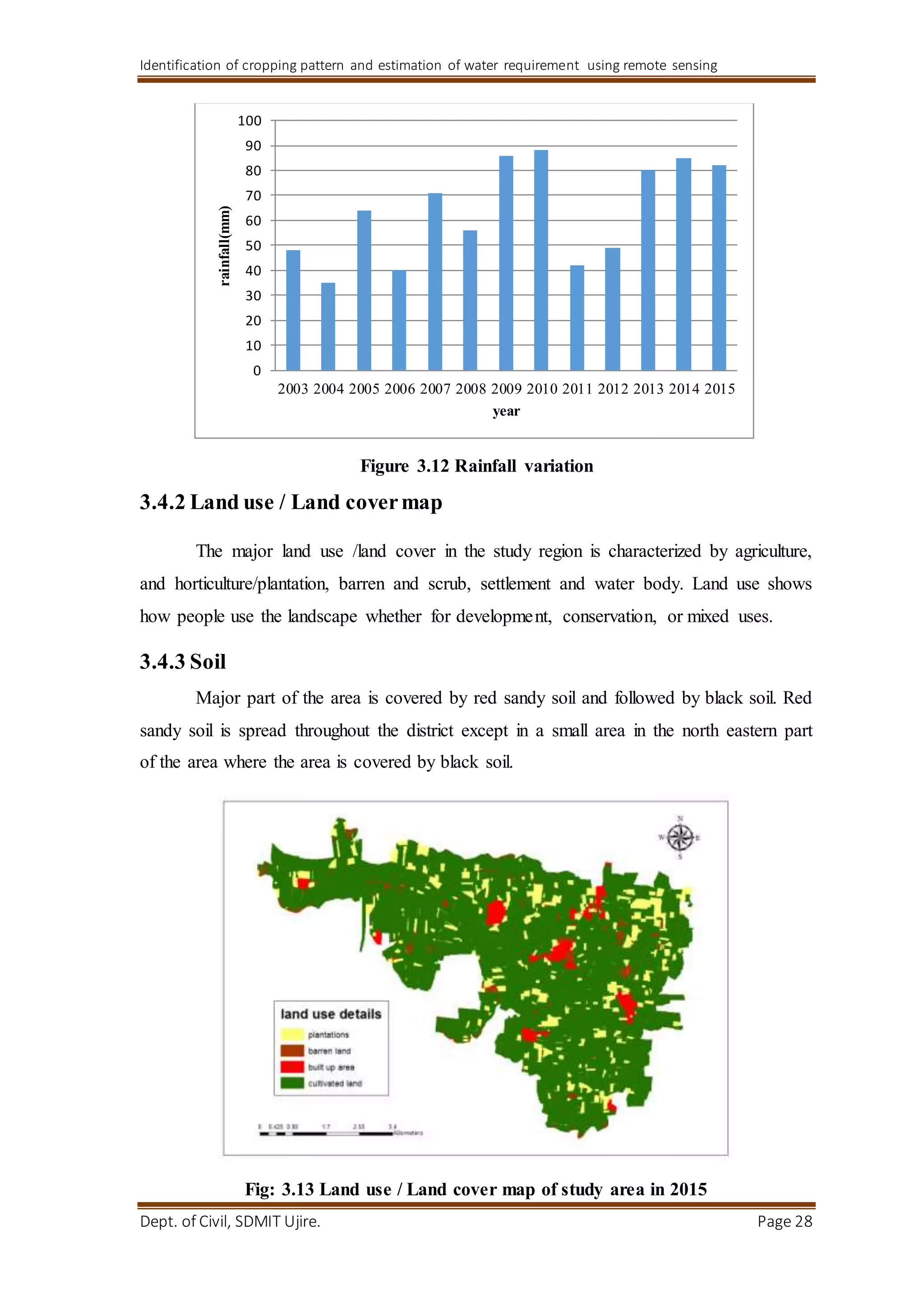


![Identification of cropping pattern and estimation of water requirement using remote sensing
Dept. of Civil, SDMIT Ujire. Page 31
World Meteorological Organization, to review the FAO methodologies on crop water
requirements and to advise on the revision and update of procedures.
The panel of experts recommended the adoption of the Penman-Monteith
combination method as a new standard for reference evapotranspiration and advised on
procedures for calculation of the various parameters. By defining the reference crop as a
hypothetical crop with an assumed height of 0.12 m having a surface resistance of 70 s m-
1 and an albedo of 0.23, closely resembling the evaporation of an extension surface of
green grass of uniform height, actively growing and adequately watered, the FAO
Penman-Monteith method was developed.
The FAO Penman-Monteith method to estimate ETo can be given as:
where ETo reference evapotranspiration [mm day-1],
Rn net radiation at the crop surface [MJ m-2 day-1],
G soil heat flux density [MJ m-2 day-1],
T mean daily air temperature at 2 m height [°C],
u2 wind speed at 2 m height [m s-1],
es saturation vapour pressure [kPa],
ea actual vapour pressure [kPa],
es-ea saturation vapour pressure deficit [kPa],
Δ slope vapour pressure curve [kPa °C-1],
γ psychrometric constant [kPa °C-1].
The reference evapotranspiration, ETo, provides a standard to which:
evapotranspiration at different periods of the year or in other regions can be compared
evapotranspiration of other crops can be related.
The equation uses standard climatological records of solar radiation (sunshine), air
temperature, humidity and wind speed.
The FAO Penman-Monteith equation is a close, simple representation of the
physical and physiological factors governing the evapotranspiration process. By using the
FAO Penman- Monteith definition for ETo, one may calculate crop coefficients at](https://image.slidesharecdn.com/body-160611141420/75/estimation-of-irrigation-requirement-using-remote-sensing-31-2048.jpg)

![Identification of cropping pattern and estimation of water requirement using remote sensing
Dept. of Civil, SDMIT Ujire. Page 33
4.1.4.3. Air humidity
While the energy supply from the sun and surrounding air is the main driving
force for the vaporization of water, the difference between the water vapour pressure at
the evapotranspiring surface and the surrounding air is the determining factor for the
vapour removal. In humid tropical regions, notwithstanding the high energy input, the
high humidity of the air will reduce the evapotranspiration demand. In such an
environment, the air is already close to saturation, so that less additional water can be
stored and hence the evapotranspiration rate is lower than in arid regions.
4.1.4.4. Wind speed
The process of vapour removal depends to a large extent on wind and air
turbulence which transfers large quantities of air over the evaporating surface. When
vaporizing water, the air above the evaporating surface becomes gradually saturated with
water vapour. If this air is not continuously replaced with drier air, the driving force for
water vapour removal and the evapotranspiration rate decreases.
4.1.5. Atmospheric Parameters
Several relationships are available to express climatic parameters. The effect of
the principal weather parameters on evapotranspiration can be assessed with the help of
these equations.
4.1.5.1. Atmospheric pressure (P)
The atmospheric pressure, P, is the pressure exerted by the weight of the earth's
atmosphere. Evaporation at high altitudes is promoted due to low atmospheric pressure as
expressed in the psychrometric constant. The effect is, however, small and in the
calculation procedures, the average value for a location is sufficient. A simplification of
the ideal gas law, assuming 20°C for a standard atmosphere, can be employed to calculate
P:
Where
P atmospheric pressure [kPa],
z elevation above sea level [m].](https://image.slidesharecdn.com/body-160611141420/75/estimation-of-irrigation-requirement-using-remote-sensing-33-2048.jpg)
![Identification of cropping pattern and estimation of water requirement using remote sensing
Dept. of Civil, SDMIT Ujire. Page 34
4.1.5.2. Latentheat of vaporization (λ)
The latent heat of vaporization, λ, expresses the energy required to change a unit
mass of water from liquid to water vapour in a constant pressure and constant temperature
process. The value of the latent heat varies as a function of temperature. At a high
temperature, less energy will be required than at lower temperatures. As λ varies only
slightly over normal temperature ranges a single value of 2.45 MJ kg-1 is taken in the
simplification of the FAO Penman-Monteith equation. This is the latent heat for an air
temperature of about 20°C.
4.1.5.3. Psychrometric constant(γ)
The psychrometric constant, γ, is given by:
Where
γ psychrometric constant [kPa °C-1],
P atmospheric pressure [kPa],
γ latent heat of vaporization, 2.45 [MJ kg-1],
cp specific heat at constant pressure, 1.013×10-3 [MJ kg-1 °C-1],
λ ratio molecular weight of water vapour/dry air = 0.622.
The specific heat at constant pressure is the amount of energy required to increase
the temperature of a unit mass of air by one degree at constant pressure. Its value depends
on the composition of the air, i.e., on its humidity. For average atmospheric conditions a
value cp = 1.013 10-3 MJ kg-1 °C-1 can be used.
4.1.5.4Air Temperature
Agrometeorology is concerned with the air temperature near the level of the crop
canopy. Air temperature is measured with thermometers, thermistors or thermocouples.
Minimum and maximum thermometers record the minimum and maximum air
temperature over a 24-hour period. Thermographs plot the instantaneous temperature over
a day or week. Electronic weather stations often sample air temperature each minute and
report hourly averages in addition to 24-hour maximum and minimum values.](https://image.slidesharecdn.com/body-160611141420/75/estimation-of-irrigation-requirement-using-remote-sensing-34-2048.jpg)
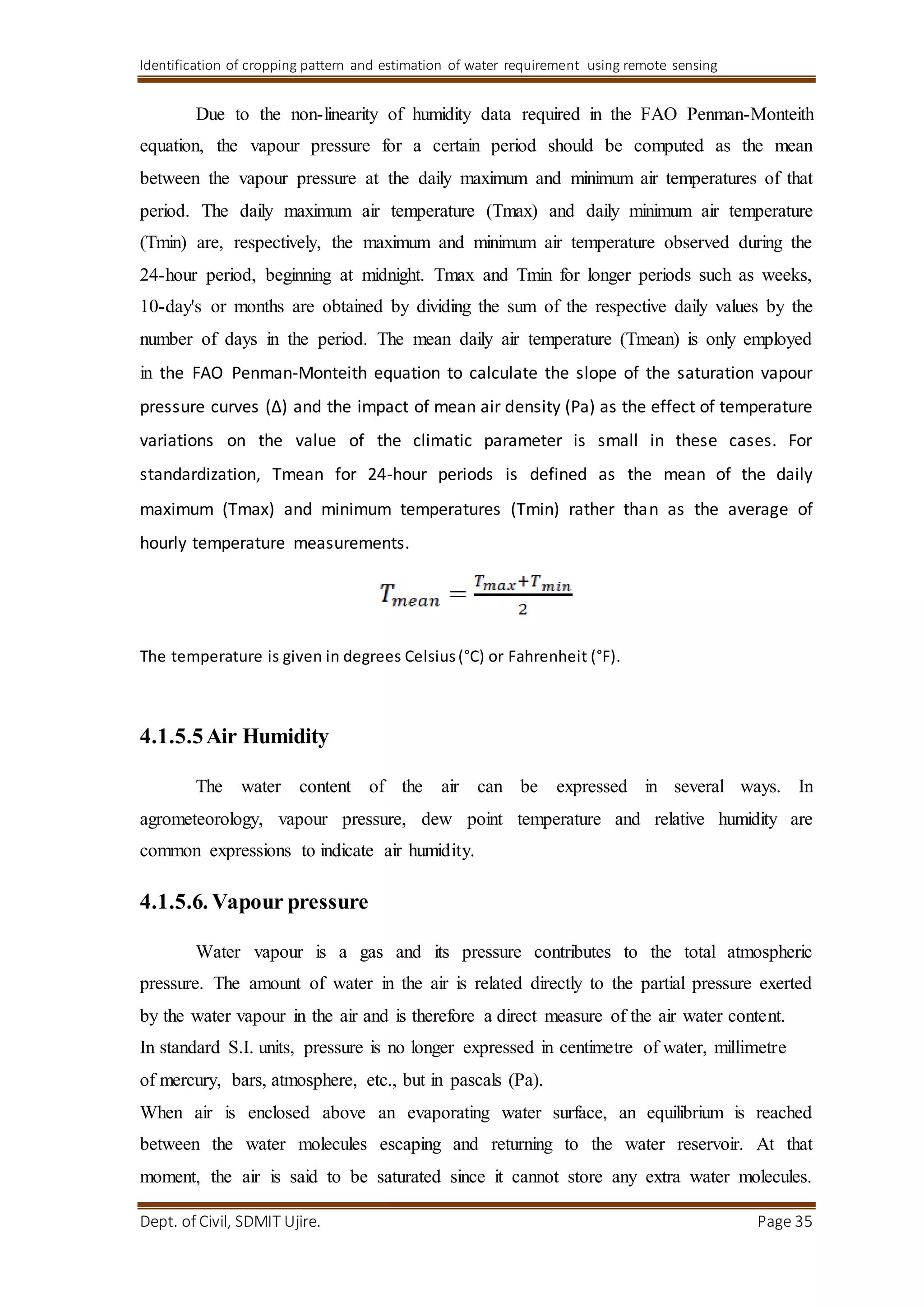

![Identification of cropping pattern and estimation of water requirement using remote sensing
Dept. of Civil, SDMIT Ujire. Page 37
4.1.6 Calculationprocedures forair humidity
4.1.6.1. Meansaturationvapour pressure (es )
As saturation vapour pressure is related to air temperature, it can be calculated
from the air temperature. The relationship is expressed by:
Where
e°(T) saturation vapour pressure at the air temperature T [kPa],
T air temperature [°C],
Due to the non-linearity of the above equation, the mean saturation vapour
pressure for a day, week, decade or month should be computed as the mean between the
saturation vapour pressure at the mean daily maximum and minimum air temperatures for
that period:
Using mean air temperature instead of daily minimum and maximum temperatures
results in lower estimates for the mean saturation vapour pressure. The corresponding
vapour pressure deficit (a parameter expressing the evaporating power of the atmosphere)
will also be smaller and the result will be some underestimation of the reference crop
evapotranspiration. Therefore, the mean saturation vapour pressure should be calculated
as the mean between the saturation vapour pressure at both the daily maximum and
minimum air temperature.
4.1.6.2. Slope ofsaturation vapour pressure curve (Δ)
For the calculation of evapotranspiration, the slope of the relationship between
saturation vapour pressure and temperature, Δ, is required.
Where
Δ = slope of saturation vapour pressure curve at air temperature T [kPa °C1],](https://image.slidesharecdn.com/body-160611141420/75/estimation-of-irrigation-requirement-using-remote-sensing-37-2048.jpg)
![Identification of cropping pattern and estimation of water requirement using remote sensing
Dept. of Civil, SDMIT Ujire. Page 38
T = air temperature [°C],
In the FAO Penman-Monteith equation, where Δ occurs in the numerator and
denominator, the slope of the vapour pressure curve is calculated using mean air
temperature
4.1.6.3. Actual vapour pressure (ea ) derived from relative humidity
data
The actual vapour pressure can also be calculated from the relative humidity.
• For RHmean:
In the absence of RHmax and RHmin, this equation can be used to estimate ea:
where RHmean is the mean relative humidity, defined as the average between
RHmax and RHmin.
4.1.6.4. Vapour pressure deficit (es – ea )
The vapour pressure deficit is the difference between the saturation (es) and actual
vapour pressure (ea) for a given time period. For time periods such as a week, ten days or
a month es is computed from Equation 3.8 using the Tmax and Tmin averaged over the
time period and similarly the ea is computed with equation 4.10, using average
measurements over the period
4.1.7. Radiation
4.1.7.1Extraterrestrialradiation (Ra )
The radiation striking a surface perpendicular to the sun's rays at the top of the
earth's atmosphere, called the solar constant, is about 0.082 MJ m-2 min-1. The local
intensity of radiation is, however, determined by the angle between the direction of the
sun's rays and the normal to the surface of the atmosphere. This angle will change during
the day and will be different at different latitudes and in different seasons. The solar](https://image.slidesharecdn.com/body-160611141420/75/estimation-of-irrigation-requirement-using-remote-sensing-38-2048.jpg)
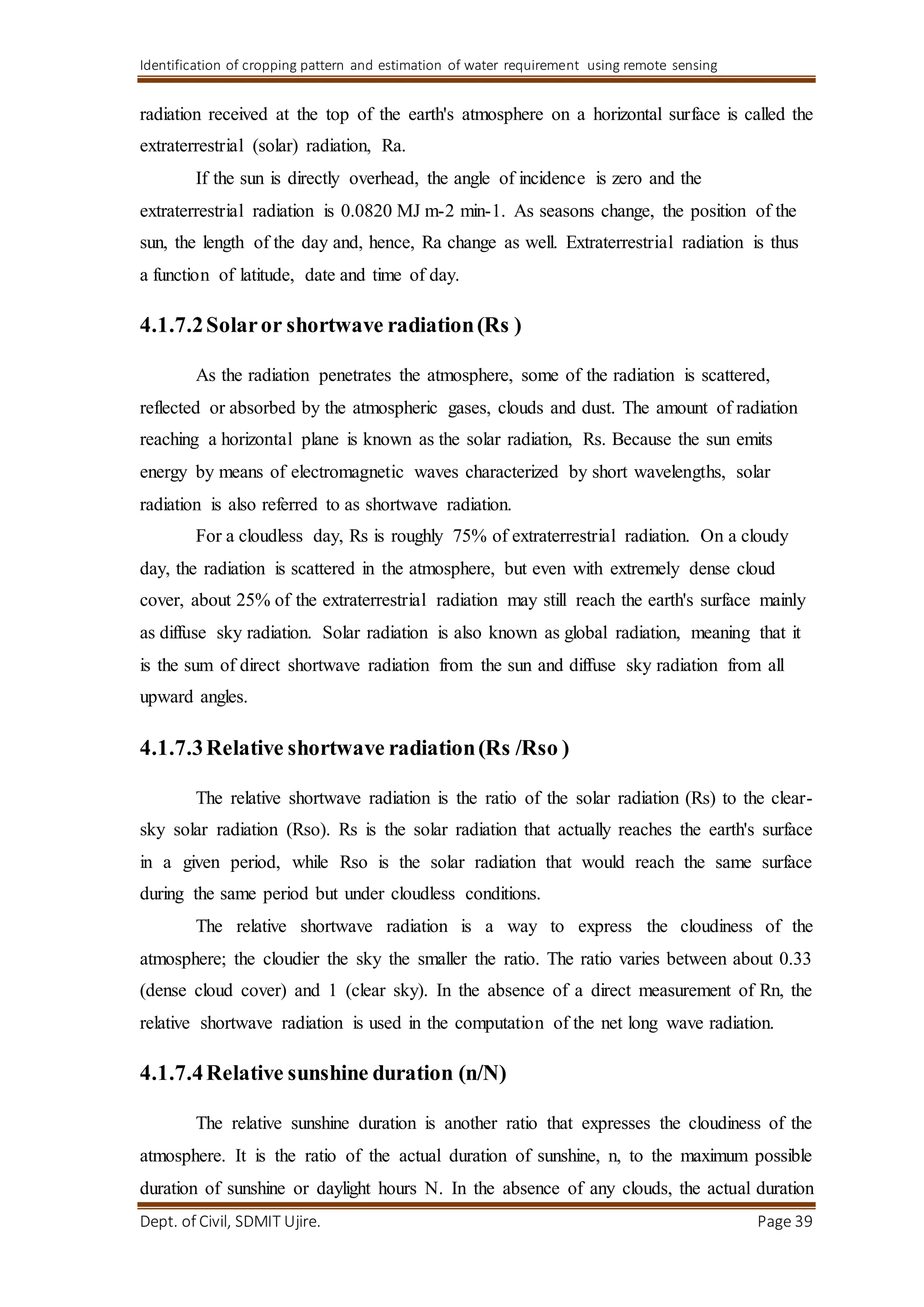
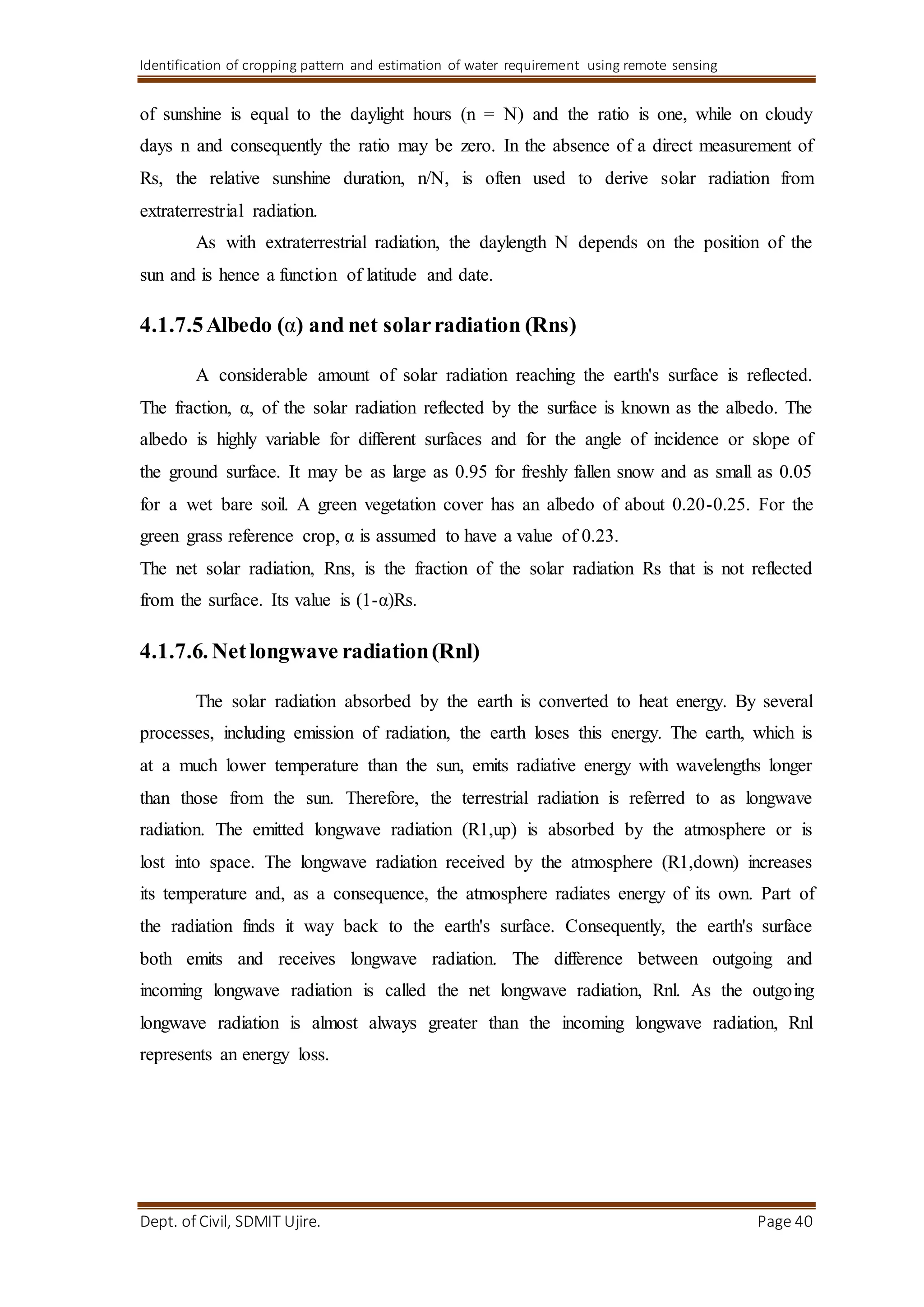

![Identification of cropping pattern and estimation of water requirement using remote sensing
Dept. of Civil, SDMIT Ujire. Page 42
4.1.8 Calculationprocedures forradiation
4.1.8.1. Extraterrestrialradiation(Ra)
The extraterrestrial radiation (Ra) value is calculated by selecting a value in
mm/day from Table 10 for given month and latitude of FAO Irrigation and Drainage
Paper No.24, as there were no sufficient data available for the equation suggested by FAO
Irrigation and Drainage Paper No.56.
4.1.8.2Solarradiation (Rs )
If the solar radiation, Rs, is not measured, it can be calculated with the Angstrom
formula,This relates solar radiation to extra-terrestrial radiation and relative sunshine
duration:
Where
Rs solar or shortwave radiation [MJ m-2 day-1],
n actual duration of sunshine [hour],
N maximum possible duration of sunshine or daylight hours [hour],
n/N relative sunshine duration [-],
Rs extraterrestrial radiation [MJ m-2 day-1],
as regression constant, expressing the fraction of extraterrestrial radiation
reaching the earth on overcast days (n = 0),
as+bs fraction of extraterrestrial radiation reaching the earth on clear days (n = N).
Rs is expressed in the above equation in MJ m-2 day-1. The corresponding
equivalent evaporation in mm day-1 is obtained by multiplying Rs by 0.408
Depending on atmospheric conditions (humidity, dust) and solar declination
(latitude and month), the Angstrom values as and bs will vary. Where no actual
solar radiation data are available and no calibration has been carried out for
improved as and bs parameters, the values as = 0.25 and bs = 0.50 are
recommended.
4.1.8.3Clear-skysolarradiation (Rso )
The calculation of the clear-sky radiation, Rso, when n = N, is required for computing net
long wave radiation.](https://image.slidesharecdn.com/body-160611141420/75/estimation-of-irrigation-requirement-using-remote-sensing-42-2048.jpg)
![Identification of cropping pattern and estimation of water requirement using remote sensing
Dept. of Civil, SDMIT Ujire. Page 43
• For near sea level or when calibrated values for as and bs are available:
Where
Rso clear-sky solar radiation [MJ m-2 day-1],
as+bs fraction of extraterrestrial radiation reaching the earth on clear-sky days
(n=N).
4.1.8.4Netsolaror net shortwave radiation (Rns )
The net shortwave radiation resulting from the balance between incoming and
reflected solar radiation is given by:
where
Rns = net solar or shortwave radiation [MJ m-2 day-1],
α = albedo or canopy reflection coefficient, which is 0.23 for the hypothetic grass
reference crop [dimensionless],
Rs = the incoming solar radiation [MJ m-2 day-1].
Rns is expressed in the above equation in MJ m-2 day-1.
4.1.8.5 Net longwave radiation (Rnl )
The rate of longwave energy emission is proportional to the absolute temperature
of the surface raised to the fourth power. This relation is expressed quantitatively by the
Stefan-Boltzmann law. As humidity and cloudiness play an important role, the Stefan-
Boltzmann law is corrected by these two factors when estimating the net outgoing flux of
longwave radiation. It is thereby assumed that the concentrations of the other absorbers
are constant:
where
Rnl net outgoing longwave radiation [MJ m-2 day-1],
σ Stefan-Boltzmann constant [ 4.903 10-9 MJ K-4 m-2 day-1],](https://image.slidesharecdn.com/body-160611141420/75/estimation-of-irrigation-requirement-using-remote-sensing-43-2048.jpg)
![Identification of cropping pattern and estimation of water requirement using remote sensing
Dept. of Civil, SDMIT Ujire. Page 44
Tmax,K maximum absolute temperature during the 24-hour period [K = °C
+273.16],
Tmin,K minimum absolute temperature during the 24-hour period [K = °C +
273.16],
ea actual vapour pressure [kPa],
Rs/Rso relative shortwave radiation (limited to ≤ 1.0),
Rs measured or calculated solar radiation [MJ m-2 day-1],
Rso calculated clear-sky radiation [MJ m-2 day-1].
An average of the maximum air temperature to the fourth power and the minimum air
temperature to the fourth power is commonly used in the Stefan-Boltzmann equation for
24- hour time steps. The term (0.34-0.14√ea) expresses the correction for air humidity,
and will be smaller if the humidity increases. The effect of cloudiness is expressed by
(1.35 Rs/Rso - 0.35). The term becomes smaller if the cloudiness increases and hence Rs
decreases. The smaller the correction terms, the smaller the net outgoing flux of longwave
radiation. Note that the Rs/Rso term in Equation 3.17 must be limited so that Rs/Rso ≤
1.0.
4.1.8.6Netradiation (Rn )
The net radiation (Rn) is the difference between the incoming net shortwave
radiation (Rns)
and the outgoing net longwave radiation (Rnl):
As the magnitude of the day or ten-day soil heat flux beneath the grass reference surface
is relatively small, it may be ignored
4.1.9 Actual evapotranspiration:
Actual evapotranspiration is calculated by multiplying crop coefficient with the
reference evapotranspiration. It is given by
where
ETc crop evapotranspiration [mm d-1],
Kc crop coefficient [dimensionless],](https://image.slidesharecdn.com/body-160611141420/75/estimation-of-irrigation-requirement-using-remote-sensing-44-2048.jpg)
![Identification of cropping pattern and estimation of water requirement using remote sensing
Dept. of Civil, SDMIT Ujire. Page 45
ETo reference crop evapotranspiration [mm d-1]
Month
Min
Temp
Max
Temp Humidity Wind Sun Rain
°C °C % km/day hours Mm
January 16.3 30.1 66 69 8.5 0
February 18.2 32.8 65 77 8.4 0
March 20.8 35.5 57 34 8.8 21.2
April 22.9 36.5 57 41 9 25.2
May 23 35.2 61 65 7.6 115
June 22.1 30.5 27 49 4 89.2
July 21.5 28.1 75 75 1.9 153.6
August 21.5 28.3 73 79 3.8 99.2
September 20.8 29.3 72 35 4.6 330.2
October 20.6 30 69 48 5.2 105.2
November 18.3 29.3 67 172 9.8 26.2
December 16.1 29 66 79 3.8 0
Table 4.1 Hydrometeorological data for 2015
4.2 Estimation of cropping pattern
The identification of cropping pattern was done using ARC GIS 10.1 supervised
classification was carried out. Training samples were prepared using the ground truth data
that was collected in the field the following ground truth data was collected in the field in
2015
Latitude N Longitude E Borewell
Dia
Borewell
Depth
Double Crop Single Crop
14 24 30.5 75 50 12.4 3.5 250 paddy
14 24 31.3 75 50 8.4 3.5 250 paddy
14 24 30.5 75 50 6.3 3.5 250 paddy
14 24 6.15 75 50 0.17 3 250 paddy
14 24 39.6 75 49 59.7 3 250 paddy
14 24 41.3 75 49 59.7 3 250 barley
14 24 36.4 75 50 1.2 3 250 maize
14 24 34.7 75 50 3 4.5 250 paddy
14 24 28.8 75 50 2 4.5 250 paddy](https://image.slidesharecdn.com/body-160611141420/75/estimation-of-irrigation-requirement-using-remote-sensing-45-2048.jpg)
